Commission, May 4, 2016, No M.7864
EUROPEAN COMMISSION
Decision
TRELLEBORG / CGS HOLDING
Dear Sir/Madam,
Subject: Case M.7864 - TRELLEBORG / ČGS HOLDING
Commission decision pursuant to Article 6(1)(b) of Council Regulation No 139/2004 (1) and Article 57 of the Agreement on the European Economic Area (2)
(1) On 30 March 2016, the European Commission received a notification of a proposed concentration pursuant to Article 4 of the Merger Regulation by which Trelleborg AB ("Trelleborg" or the "Notifying Party") would acquire sole control over ČGS Holding a.s. ("ČGS") (the "Transaction"). (3) Trelleborg and ČGS are jointly referred to as the "Parties".
1. THE PARTIES
(2) Trelleborg is a limited liability company listed on the Nasdaq Stockholm stock exchange and headquartered in Trelleborg, Sweden. Trelleborg is active in the manufacture and supply of rubber products, including in particular, tyres, polymer based solutions, seals, and anti-vibration systems (although it has recently announced the sale of its anti-vibration solutions business). (4)
(3) ČGS is a privately owned company based in the Czech Republic. ČGS is active in the manufacture and supply of rubber products, including in particular, tyres, polymer based solutions, seals, and anti-vibration systems.
2. THE OPERATION AND THE CONCENTRATION
(4) Through the Transaction, Trelleborg would acquire all of the issued shares in and sole control over ČGS from its current owners pursuant to the terms of a Share Purchase Agreement entered into on 6 November 2015.
(5) Therefore, the Transaction constitutes a concentration within the meaning of Article 3(1)(b) of the Merger Regulation.
3. EU DIMENSION
(6) The undertakings concerned have a combined aggregate worldwide turnover of more than EUR 2 500 million (5) [Trelleborg EUR 2,474 million; ČGS EUR 610 million]. The combined aggregate EEA-wide turnover of the Parties exceeds EUR 100 million and the aggregate turnover of each Party exceeds EUR 25 million in [three EU Member States]. The Union-wide turnover of each Party exceeds EUR 100 million [Trelleborg EUR […]; ČGS EUR […]], and they do not each achieve more than two-thirds of their aggregate EU-wide turnover within one and the same Member State.
(7) Therefore, the Transaction has an EU dimension as it meets the thresholds set in Article 1(3) of the Merger Regulation.
4. MARKET DEFINITION
(8) The Transaction gives rise to affected markets in three areas: (i) agricultural tyres; (ii) tyres for earthmoving vehicles and forklifts; (industrial tyres); and (iii) other rubber based products.
4.1. Tyres
4.1.1. Relevant product markets
General
(9) Trelleborg and ČGS are both active in the production and supply of tyres for agricultural and forestry vehicles as well as for earthmoving vehicles and forklifts. In addition, ČGS is active in the production and supply of tyres for two-wheel vehicles. (6)
(10) In past cases, the Commission has distinguished the sale of tyres to Original Equipment Manufacturers ("OEM") from new replacement tyres ("RT"). (7) OEM tyres are sold directly from the tyre manufacturer to the vehicle manufacturer without passing through an intermediary for installation on new vehicles. Although manufacturers can supply major accounts with replacements tyres directly, the vast majority of RT are sold through specialised outlets or tyre dealers who obtain their supplies from the manufacturer through its wholesale operations. The intermediaries in this market are usually specialised tyre dealers or dealers that, together with the retailing of tyres, perform a wide range of others services connected to the maintenance of vehicles.
(11) Moreover, the Commission concluded in past cases that within each of the OEM and RT categories it is possible to distinguish six product markets according to the specific characteristics and dimensions of the vehicles on which tyres have to be fitted:
- tyres for cars and vans;
- tyres for trucks and buses;
- tyres for earth moving vehicles;
- tyres for agricultural use;
- tyres for two wheels motorized vehicles; and
- tyres for two wheels non-motorized vehicles. (8)
(12) The Commission found that, on the demand side, the fact that it is not possible to switch between tyres belonging to distinct product markets is related to the different product characteristics (notably dimensions) and the different usage and applications of these tyres. (9) For instance, a tyre manufactured to be fitted on an earthmoving vehicle will not fit on a light truck given the different dimensions of these vehicles and the different needs they have when operating. Moreover, on the supply-side, tyre manufacturers are not able to switch their production from, for example, a forklift tyre to an agricultural tyre in the short-term, without incurring significant additional costs or risks. Specific production facilities and moulds are needed to manufacture tyres belonging to different categories of vehicles and high investments are necessary to become an effective competitor on a specific tyre product, thus making supply substitution unlikely between tyres destined for different categories of vehicles.
(13) The Notifying Party is of the view that the segmentations described above accurately reflect market dynamics.
(14) The majority of respondents to the market investigation agrees with the distinctions made in previous cases between the OEM and RT markets (10) and within each of these markets among tyres for: (i) cars and vans; (ii) trucks and buses; (iii) earth moving vehicles; (iv) agricultural use; (v) two wheels motorized vehicles; and (vi) two wheels non-motorized vehicles. (11) Moreover, replies to the market investigation indicated that the different types of tyres are not substitutable with one another (12) and that if faced with a 5-10% price increase in price for tyres for a given application customers would not switch to those for a different application because of differences in technical characteristics, performance, and price. (13)
Agricultural tyres
(15) The Notifying Party submits that agricultural tyres of different sizes are not substitutable with one another because they cannot be fitted on the same vehicles. On this basis, within the broader agricultural tyre market they distinguish the following sub-segments:
- Large rear tyres;
- Rear agri narrow;
- Trailer & implement;
- Industrial & multi-purpose tyres ("MPT");
- Rear forestry;
- Front wheels; and
- Small agro gardening equipment.
(16) The Notifying Party further submits that large rear agricultural tyres can be further segmented depending on their size into XL, 65, 70, and standard because large rear tyres of different sizes are used for somewhat different applications. The more horsepower an agricultural vehicle has the bigger its rear tyres need to be.
(17) The majority of respondents to the market investigation agrees with the distinction made by the Notifying Party among agricultural tyres of different sizes. (14) Moreover, replies to the market investigation indicated that the different types of tyres are not substitutable with one another (15) and that if faced with a 5-10% price increase in price for a given size (e.g. large rear tyres) customers would not switch to those of a different size (e.g. front wheels) because of differences in technical characteristics, price, and sizes. (16) The majority of respondents to the market investigation also agrees with the potential distinction made by the Notifying Party among large rear tyres of different sizes. (17) However, replies to the market investigation indicated that large rear tyres of different sizes are substitutable with one another or that, in any event, a certain degree of substitutability exists among large rear tyres, in particular among 65, 70, and standard tyres. (18)
(18) For the purpose of assessing the present Transaction, it is not necessary to determine whether agricultural tyres of different sizes belong to the same relevant product market or whether large rear agricultural tyres of different sizes belong to the same relevant product market since the proposed Transaction would not lead to serious doubts as to its compatibility with the internal market under any plausible product market definition.
Industrial tyres
(19) As regards tyres for earthmoving vehicles and forklifts, the Notifying Party submits that due to their different dimensions and product characteristics, tyres for earthmoving vehicles are normally not suitable with tyres for forklifts and vice versa, although there is a limited number of tyre sizes that can, theoretically, be used for both earthmoving vehicles and for forklifts. The Notifying Party in particular considers that in practice, there is virtually no demand-side substitutability as the tyres from one or the other category do not have the necessary characteristics (e.g. in terms of temperature build-up within the tyre) to perform adequately in the other category. Moreover, despite the fact that tyres for earthmoving vehicles and for forklifts are largely based on similar technologies and production techniques (if one looks separately at solid and pneumatic tyres) and the fact that several suppliers of earthmoving tyres also offer forklift tyres, the tyre manufacturers are generally not able to easily switch their production from one vehicle category to another due to the need for specific production facilities and moulds.
(20) The majority of respondents to the market investigation confirmed the relevance of the distinction between tyres for forklifts and tyres for other industrial applications. There are differences in price and distribution channels as well as specific loading capacities, dimensions and other technical specifications which must be followed regarding forklift tyres (19). Moreover, if faced with a 5-10% price increase, customers of forklift tyres would not likely switch to tyres manufactured for other purposes20. Equally, a majority of manufacturers of forklift tyres confirmed that their customers would not in case of such price increase switch to tyres manufactured for other purposes. (21) However, when asking manufacturers of forklift tyres about ease of switching production between forklift tyres and other types of tyres, respondents were split regarding supply-side substitutability. (22) The respondents, for example, commented that the amount of the necessary investment in the production equipment would depend on the capacity required and the size range of the tyres, amongst others.
(21) As regards tyres for earthmoving vehicles the Notifying Party submits that, on the basis of the vehicle on which they are intended to be mounted, they can be segmented into tyres for loaders, graders, articulated dump trucks, rigid dump trucks and cranes.
(22) The market investigation was inconclusive as to the relevance of these segmentations. The majority of RT customers responding to the market investigation confirm the relevance of the distinction with regard to tyres for loaders and graders which they consider as not substitutable with one another because of, among others, differences in technical characteristics and intended use. (23) Moreover, the majority of the Parties' RT customers also indicated that if faced with a 5-10% price increase in one of the categories e.g. tyres for loaders, their end customers would not switch to tyres for graders and vice versa. (24) However, while there would seem to be no or limited demand-side substitutability, (25) suppliers indicated that it is generally very easy to switch production between tyres for loaders and tyres for graders and vice versa. (26)
(23) For the purposes of assessing the present Transaction, it is not necessary to determine whether tyres for forklifts and earthmoving vehicles form separate markets or whether tyres designed for earthmoving vehicles should be further segmented into loaders, graders, articulated dump trucks, rigid dump trucks and cranes since the Transaction would not lead to serious doubts as to its compatibility with the internal market under any plausible product market definition.
Pneumatic v solid tyres and bias v radial tyres
(24) The Notifying Party considers that tyres can be further distinguished depending on their composition and construction.
(25) On the basis of their composition, tyres can be split into pneumatic and solid. Pneumatic tyres are air-filled whereas solid tyres consist of solid materials that are wrapped around the wheel. The main difference between these two types of tyres consists in the fact that solid tyres push into the road surface whereas pneumatic tyres sits on top of the road surface. Therefore, pneumatic tyres are sensitive to their own air pressure, while solid tyres are sensitive to the surface on which they are used. Solid and pneumatic tyres are typically used in different applications.
(26) Taking into account their construction, pneumatic tyres can be split into bias and radial. In bias (or cross-ply or x-ply or diagonal) tyres, the cord plies overlap each other diagonally. Radial tyres are tyres for which the cord plies run like strings through the layers of rubber to give the rubber stability, and are aligned so that they run at 90 degrees to the direction of travel. Radial tyres generate less heat build-up and provide better ability to carry loads, less rolling resistance (better fuel mileage), longer wear and a more comfortable ride than bias tyres. Bias and radial tyres are generally sold at different prices, with radial tyres being often the more expensive category.
(27) For the purpose of assessing the present Transaction, it is not necessary to determine whether pneumatic and solid tyres or pneumatic bias and radial tyres belong to the same relevant product market since the proposed Transaction would not lead to serious doubts as to its compatibility with the internal market under any plausible product market definition.
(28) Therefore, the Commission will assess the impact of the Transaction separately for OEM and RT tyres and within each category it will assess separately agricultural tyres, tyres for earthmoving vehicles (in particular loaders and graders) and tyres for forklifts. Moreover, the Commission will distinguish between bias and radial tyres as well as solid and pneumatic tyres, and take into account the differences in tyre size, as relevant.
4.1.2. Relevant geographic markets
Tyres for OEM customers
(29) In line with past Commission decisions, the Notifying Party submits that the markets for OEM tyres are at least EEA-wide. (27) The Notifying Party considers that this conclusion is supported by the fact that: (i) each tyre manufacturer concentrates its production in a limited number of factories within and/or outside of the EEA from which tyres are shipped across the EEA; (28) (ii) large OEM customers source their tyre requirements centrally at the EEA, if not worldwide, level; and (iii) there are no material barriers to trade within the EEA or, indeed, for imports from outside the EEA.
(30) The majority of respondents to the market investigation agreed with this definition. First, in the majority, supply contracts and prices are negotiated between tyre manufacturers and OEM customers on a worldwide or EEA-wide basis. (29) Second, respondents reported that there are no material price differences between EEA Member States or clusters of EEA Member States at the OEM level. (30) Third, the majority of respondents do not consider that transport costs (31) or import duties (32) hinder the ability to import tyres into the EEA.
(31) The Commission considers that the exact geographic market definition for sales of tyres to OEMs can be left open as the Transaction does not raise serious doubts as to its compatibility with the internal market even under the narrowest possible market definition (at an EEA-wide level). The Commission considers this is applicable for all types of tyres sold to OEMs affected by the Transaction.
Tyres for RT customers
(32) In past cases regarding the RT sector, the Commission has found RT markets to be national in scope, although it has noted a trend towards EEA-wide geographic markets. (33) This has been found to be the case for RT for: (i) cars and vans; (ii) trucks and buses; (iii) earth moving vehicles; (iv) agricultural; (v) two wheels motorized vehicles; and (vi) two wheels non-motorized vehicles. The Commission has not considered the geographic RT market specifically for forklifts in previous cases.
(33) The Notifying Party is of the view that the RT markets for all tyres affected by the Transaction are EEA-wide given that barriers to trade within the EEA are low and that many RT dealers are active in several EEA Member States and actively try to win customers across national borders. The Notifying Party has also submitted that certain regional markets may exist, in particular, the Baltics (Estonia, Latvia, Lithuania) and the UK/Ireland.
(34) Replies to the market investigation do not appear to fully support the claim of EEA-wide markets. The majority of agricultural RT customers are active in only one Member State (34) and a number of those active in multiple Member States still have national procurement teams. (35) In particular, supply contracts and prices are negotiated between tyre manufacturers and RT customers on a national basis. (36) The vast majority of forklift and earthmoving RT customers are active in only one Member State, although there are a small number of regional players (moreover, some tyre manufacturers own EEA-wide distribution networks).
(35) On the other hand, replies to the market investigation did indicate that certain regional markets may exist. In particular, a significant proportion of RT customers who are active in the Baltic region (Estonia, Latvia, Lithuania) are active across all three Baltic Member States and considerable interstate trade takes place. The same applies to the UK/Ireland. (37) Moreover, replies to the market investigation indicated that there are limited price differences between Member States. (38)
(36) Finally, elements suggesting an EEA-wide, if not wider, market relate to the level of imports. In all tyre markets imports from Asia play a significant role. For example, in respect of forklift tyres, the Parties estimate that roughly 70% of the pneumatic RT sold in the EEA are imported. Import duties and transport costs do not play a major role for most tyre types in the RT markets. That being said, lead time on delivery, reliability of supply, local sales teams, local technical support teams and local warehousing facilities are maybe necessary (39), thus pointing more towards national markets.
(37) For the purposes of this decision, the Commission will assess the Transaction on the basis of a national market definition as well as at a wider regional level for the Baltic region and the UK/Ireland. The exact geographic market definition can, however, be left open as the Transaction does not raise serious doubts as to its compatibility with the internal market even under the narrowest possible market definition (national). The Commission considers this to be applicable for all types of tyres sold on the RT markets affected by the Transaction.
4.2. Other rubber based products
(38) In addition to tyres, the Parties' activities overlap also in the production and supply of a range of other rubber based products, that is: (i) polymer based sheets and fabrics; (ii) polymer based products for sealing and other applications; (iii) anti- vibration systems; (iv) polymer based inflatable products; (v) polymer based consumables for printing and other applications; and (vi) rubber compounds.
4.2.1. Polymer based sheets and fabrics
(39) The Parties' activities overlap in the production and supply of: (i) coated fabrics; (40) and (ii) technical rubber sheets (TRS). (41) There is no previous Commission decision concerning either category. Both coated fabrics and TRS can be further divided according to end-application.
(40) The Notifying Party submits that the scope of the relevant geographic market is at least EEA-wide. Both Parties produce these products in one location in the EEA from which they sell across the EEA. Products are sold directly to the final product manufacturers or through independent third-party distributors who source them at least on an EEA-wide, if not global, basis.
(41) The product and geographic market definitions can, however, be left open as no affected markets arise even on the basis of the narrowest possible segmentations. These products will therefore not be discussed further in this decision.
4.2.2. Polymer based products for sealing and other applications
(42) The Parties' activities overlap with regard to: (i) rubber moulded parts; (42) (ii) rubber profiles; and (iii) sealing solutions.
(43) Rubber moulded parts and rubber profiles: The Notifying Party submits that rubber moulded parts and rubber profiles can be further segmented according to whether they are manufactured from rubber or silicone rubber and by end- application. The Commission has not previously considered these products.
(44) The Notifying Party submits that the scope of the relevant geographic markets are at least EEA-wide. Rubber moulded parts and rubber profiles tend to be small and light and can easily be shipped across the EEA. Moreover, customers are typically sophisticated industrial players/distributors that tend to procure moulded parts on an at least EEA-wide, if not global, basis.
(45) The product and geographic market definitions can, however, be left open as no affected markets arise even on the basis of the narrowest possible segmentations. These products will therefore not be discussed further in this decision.
(46) Sealing solutions: (43) In SHV/ERIKS, the Commission endorsed the concept of a broad market including products made of various materials such as rubber, silicones or metal. In terms of applications, the Commission made a general distinction between automotive sealings and sealings used in other applications ("industrial sealings"). While some elements identified during the market investigation in that case suggested that with regard to industrial sealings a further segmentation may be appropriate distinguishing between: (i) static sealings and gaskets; (ii) hydro pneumatic sealings; (iii) rubber moulded sealings;
(iv) mechanical seals; and (v) expansion joints; other responses suggested that all industrial seals form part of one overall market. (44) The Commission considered the markets to be at least EEA-wide.
(47) The Notifying Party submits that there is a high degree of supply-side substitutability between the various types of sealing solutions and applications since most suppliers of sealing solutions are present across several and often all categories and they have the ability to produce sealing solutions to the requisite specifications of any customers. Moreover, the Notifying Party does not consider that a distinction between: (i) static sealings and gaskets; and (ii) moulded sealings is relevant or possible; since the former will typically also include moulded elements. Market data for: (i) static sealings and gaskets: and (ii) rubber moulded sealings has therefore been provided as part of one segment. Further, the term "mechanical seal" refers to a specific sub-category of "rotary seals" whereas the Parties also offer other types of rotary seals. Market data has therefore not been provided for a segment limited to mechanical seals but for rotary seals overall.
(48) On this basis, the only area where an affected market arises is in respect of hydropneumatic sealings. The exact product and geographic market definitions can, however, be left open as no serious doubts arise even on the basis of the narrowest possible segmentations.
4.2.3. Anti-vibration systems (45) (46)
(49) Anti-vibration systems have been addressed by the Commission in a number of previous merger decisions. (47) The key distinction made is by end-application into: (i) automotive; (ii) railway; and (iii) (other) industrial applications.
(50) Within the automotive segment the Commission has examined additional potential sub-segments defined along the lines of individual AVS components, namely: (i) engine mounts; (ii) chassis and suspension mounts and bushes; (iii) exhaust hangers; (iv) mass dampers; (v) torsional vibration dampers; (vi) micro-cellular polyurethane bumpers; and (vii) air springs. In addition, the Commission has considered a distinction between AVS for passenger cars and commercial vehicles.
(51) A further subdivision into conventional and hydraulic anti-vibration products has also been examined. In the present case, no overlap arises with regard to hydraulic AVS, as ČGS does not engage in the production or supply of hydraulic anti- vibration parts.
(52) Finally, the Commission has considered a possible distinction between, on the one hand, sales to original equipment manufacturers ("OEM") and, on the other hand, sales to the independent after-market ("IAM"). In the case at hand, the overlap between the Parties in the IAM segment is marginal. (48)
(53) The Commission has so far considered that the market for AVS and possible sub- markets are at least EEA-wide (with the exception of the automotive IAM segment which could instead be regional) but has ultimately left open the exact geographic market definition. (49)
(54) The Commission considers that the product and geographic market definitions regarding automotive AVS (as well as railway and industrial AVS) can be left open since no concerns arise even under the narrowest possible segmentations.
4.2.4. Polymer based inflatable products
(55) Regarding polymer based inflatable products, both Parties are active in the production and sale of: (i) packers; (ii) lifting bags; and (iii) pipe plugs; in the EEA. There has been no Commission precedent dealing with these products.
(56) Packers: (50) The Notifying Party submits that packers are fairly commoditised products requiring a low level of technical engineering and know-how. They are available in several diameters in order to fit pipes of different sizes. That being said, sizes are largely standardised across the industry and all packers are produced using the same methods and equipment. All the main suppliers active in the EEA therefore have a fairly comparable offering. (51)
(57) Lifting bags: (52) Lifting bags come in different shapes and sizes which, however, are largely standardised. The Notifying Party submits that there is a high degree of supply-side substitutability since manufacturing techniques and tools are largely the same across all shapes and sizes. Indeed, all suppliers in the EEA that are active in this area tend to offer a largely comparable assortment of lifting bags. Moreover, lifting bags being used across all applications tend to be largely similar.
(58) Pipe plugs: (53) Pipe plugs come in different shapes and sizes which, however, are largely standardised. Moreover, pipe plugs are used in a number of end- applications such as oil, gas water etc. The Notifying Party submits that there is a high degree of supply-side substitutability since manufacturing techniques and tools are largely the same across all shapes and sizes and across all applications.
(59) The Notifying Party submits that the geographic markets for the manufacture and supply of packers, lifting bags and pipe plugs are at least EEA-wide. All products can be transferred over long distances at relatively low cost and are predominantly sold through independent distributors who tend to source these products at least on an EEA-wide, if not global, basis.
(60) The Commission considers that the product and geographic market definitions can be left open since no concerns arise even under the narrowest possible segmentations.
4.2.5. Polymer based consumables for printing and other applications
(61) The Parties' activities overlap with regard to: (i) rubber-coated rollers; (ii) coating plates; and (iii) printing blankets. There has been no Commission precedent regarding rubber coated rollers and coating plates.
(62) Rubber-coated rollers: (54) According to the Notifying Party, rubber-coated rollers can be further segmented by industry end-application. As regards the geographic scope of the market(s), since customers tend to rely on a supplier that is located in the vicinity of their factories (the rollers need to be shipped to the supplier for re- coating in regular intervals), the Notifying Party estimates that customers seeking re-coating services will normally not ship their rollers over a distance exceeding 250 km. This suggests that the relevant markets are likely to be regional. The Parties have provided market share estimates on a national basis: given that the Parties’ activities are focused on different geographic areas and that in those areas where their activities do overlap, their market shares are minimal, no affected markets can arise even on a regional basis. (55) Therefore, the product and geographic market definition can be left open and these products will not be discussed further in this decision.
(63) Coating plates: (56) According to the Notifying Party, coating plates could be further sub-segmented by the type of coating for which the plates are used. The Notifying Party submits that the scope of the market is at least EEA-wide. Products can easily be traded and shipped across borders within the EEA. (57) Also, coating plates are typically sold through third-party distributors which tend to source them at least on an EEA-wide basis.
(64) The product and geographic market definition can, however, be left open with regard to coating plates as no affected markets arise even on the basis of the narrowest possible segmentation. (58) These products will therefore not be discussed further in this decision.
(65) Printing blankets: Printing blankets are consumables used for offset and digital printing. They consist of a rubber sheet in a press that receives the inked impression and transfers it to the surface being printed. The Parties' activities overlap only as far as offset printing blankets (OPB) are concerned.
(66) The Commission has analysed the OPB industry in its Continental/Xtra Print decision (59) where it made a distinction between: (i) fabric-backed; (ii) metal- backed; and (iii) cylindrical printing blankets; and (iv) also separately looked at self-adhesive OPB. The Commission concluded that a further segmentation on the basis of the offset printing technology being used (e.g. coldset, heatset, sheet-fed etc.) would not be appropriate since broadly the same OPB are used for all printing technologies and because most suppliers offer OPB for all technologies. The markets were considered EEA-wide.
(67) The Notifying Party has, thus provided market data separately for fabric-backed OPB and self-adhesive OPB, i.e. the two OPB segments where overlaps arise.
(68) The Commission considers that the product and geographic market definitions with regard to OPB can be left open since no concerns arise even under the narrowest possible segmentations.
4.2.6. Rubber compounds (60)
(69) In its Trelleborg/Smiths (PSS Division) decision,61 the Commission considered that rubber compounds form part of a separate product market and analysed the products at an EEA-wide level. The Notifying Party agrees with this approach.
(70) In any case, the Commission considers that the precise scope of the relevant product and geographic market can be left open since the Transaction does not raise any concerns irrespective of the definition/segmentation considered as the Transaction does not give rise to any horizontally affected markets. (62)
(71) The Transaction however gives rise to several vertically affected markets, resulting from the Parties' manufacture of a multitude of products which are made at least partially of rubber compounds (63). These shall be assessed under the competitive assessment further below.
5. COMPETITIVE ASSESSMENT
5.1. Market share data
(72) The Notifying Party's market share calculations for tyres (agricultural and earthmoving) for the OEM segment are based on its own intelligence as there is no third party data for these markets. For the RT segment, the calculations are based on sales volumes reported by the European Tyre & Rubber Manufacturers Association ("ETRMA").
(73) The Parties have provided actual market share data for 2014 but only projections for 2015 as final 2015 numbers are not yet available. For these 2015 projections, the Parties have used their actual sales for January to October 2015 and estimated November and December 2015, based on sales in the same months in the previous year and overall 2015 market trend. Given that these are projections, the
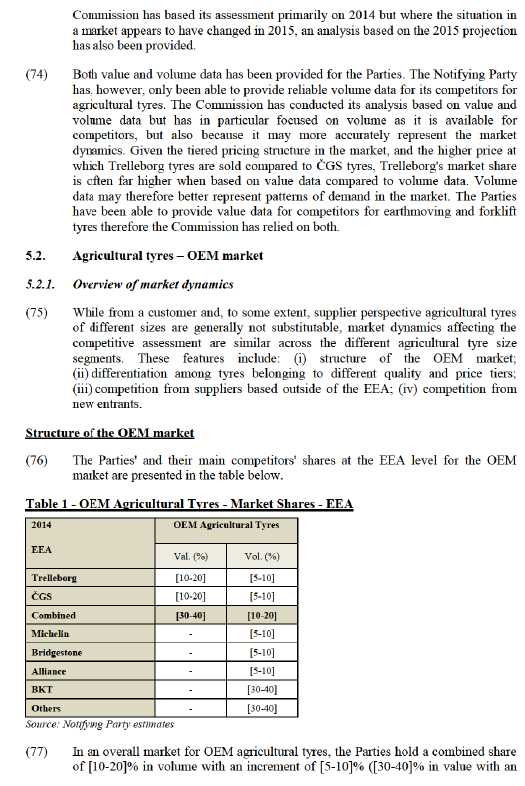
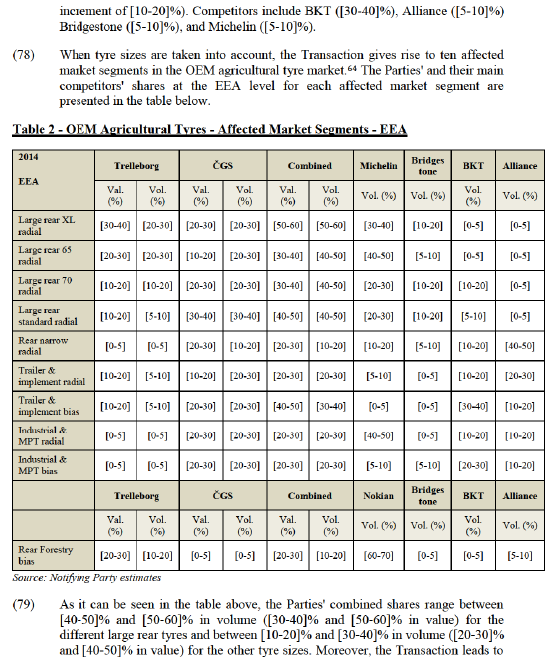
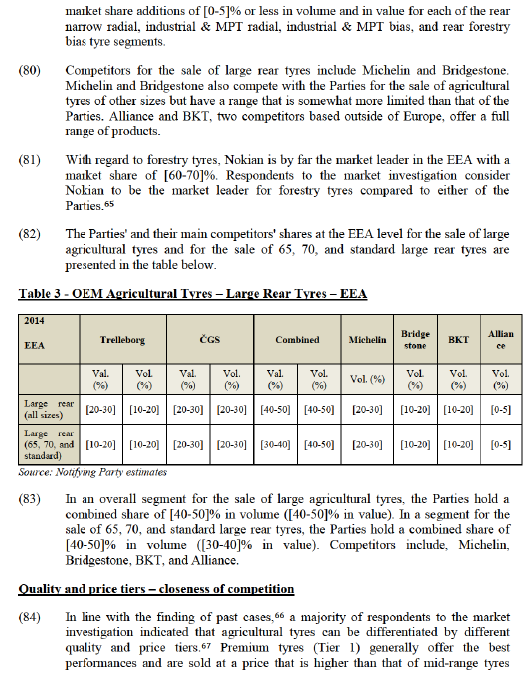
(Tier 2). Economy tyres (Tier 3) are normally less performing and are sold at a price that is lower than premium and mid-range tyres. In the OEM market, mid- range tyres are generally offered to customers as a standard option whereas premium tyres are generally sold at the demand of customers that accept to pay a premium for them. Economy tyres are normally mounted on low-end agricultural vehicles. The bulk of the tyres sold to OEMs in the EEA belong to the premium and mid-range tiers.
(85) The majority of OEM customers that responded to the market investigation are of the view that ČGS and Trelleborg mainly operate in two different tiers and do not consider them to be close competitors. (68) Trelleborg is mainly a supplier of premium tyres whereas ČGS offers two brands, Mitas and Mitas Premium, that sit in the mid-range tier. (69) Trelleborg's main competitor in the premium tier is Michelin which is considered by several market participants to be a market leader. (70) Michelin is active as a premium (with its Michelin brand), mid-range (with its Kleber brand) and economy (with its Taurus brand) supplier. It does not, however, generally offer its Kleber or Taurus brands to OEMs (these two brands being more focused on the RT market). ČGS mainly competes with other suppliers of mid-range tyres, in particular Bridgestone, BKT, and Alliance. Bridgestone offers both premium (with its Bridgestone brand) and mid-range (with its Firestone brand) tyres.
(86) Moreover, a majority of OEM customers that responded to the market investigation indicated that if faced with a price increase for Trelleborg tyres they would switch part of their tyre purchases to Michelin and that in case of price increase of ČGS's Mitas and Mitas Premium brands they would switch part of their purchases to BKT, followed by Firestone, Alliance, and Michelin. (71)
(87) Therefore, the Commission considers that Trelleborg and ČGS are not close competitors.
Competitors based outside of the EEA
(88) Agricultural tyre manufacturers based outside the EEA and in particular in Asia hold significant shares in certain market segments. However, they are normally not relied upon by OEM customers in the EEA for the bulk of their requirements. This is in part due to difficulties with regard to logistics. Because of the long lead times to transport tyres from outside the EEA, in particular from Asia, and limited storage facilities they hold in Europe, manufacturers based outside the EEA cannot easily adjust to fluctuations in agricultural tyre demands. Moreover, OEM customers do not hold large stocks of tyres and mostly rely on just-in-time deliveries. Competitiveness of manufacturers based outside the EEA is stronger for tyres having a small diameter as they can be more easily (and cheaply) transported and stocked than those with a large diameter.
(89) However, OEM customers that responded to the market investigation indicated that if faced with a 5-10% increase in price of agricultural tyres in the EEA they would seek new suppliers outside the EEA and, in particular, in India and China. (72) Moreover, respondents to the market investigation indicated that transport costs and import duties do not limit the import of tyres from outside the EEA. (73)
(90) Therefore, the Commission considers that there are low barriers to import agricultural tyres into the EEA and that tyre manufacturers located outside of the EEA constitute a competitive constraint on the Parties.
New entrants
(91) Continental and Pirelli have both confirmed their intention to enter the European agricultural tyre business. (74)
(92) Continental indicated that it intends to produce agricultural tyres in Portugal and is in the process of implementing its re-entry plans. (75) Continental is currently in discussions with potential customers.
(93) Pirelli will focus, at least initially, on the RT segment but has expressed interest in winning share with OEM customers in the future. Pirelli's competitiveness in the OEM segment maybe limited by the fact that it will produce its tyres for the European market in Brazil and, as is the case for other non-EEA manufacturers, it will be confronted with lead-time limitations. Pirelli is currently ramping-up its operations in Europe and has already entered into supply agreements with customers.
(94) Certain OEMs have expressed interest in working with these new entrants although some of those indicated that they are unlikely to rely on such new entrants as their main suppliers. (76)
(95) Therefore, the Commission considers that Continental and Pirelli constitute a competitive constraint on the Parties.
5.2.2. Competitive Assessment
(96) For the reasons set out below, the Commission finds that the Transaction does not give rise to serious doubts as to its compatibility with the internal market in respect of OEM agricultural tyres.
(97) First, the Transaction would not materially affect the structure of the overall OEM market in which the Parties would hold a post-Transaction share of [10-20]% in volume ([30-40]% in value) with a market share addition to Trelleborg's pre- Transaction share of [5-10]% in volume ([10-20]% in value).
(98) Second, even if the OEM market were segmented by tyre size, the Transaction would lead to market share additions of [0-5]% or less in volume and in value for each of the rear narrow radial, industrial & MPT radial, industrial & MPT bias, and rear forestry bias tyre segments and to combined shares of about [30-40]% or less in the trailer & implement bias and radial segments.
(99) Third, the Parties would face a number of strong competitors in each segment. In particular, the Parties would be mainly constrained by Michelin, Bridgestone, and BKT in the large rear tyres segments and by Michelin, Bridgestone, Alliance and BKT in the other tyre sizes.
(100) Fourth, further competition into the EEA market will be brought by Continental and Pirelli's re-entry into the agricultural tyre sector. Pirelli is expecting to be operational in Europe in the second half of 2016. Continental is currently implementing its plans to bring agricultural tyres to European customers.
(101) Fifth, as discussed above in paragraphs (85) and (86), the Parties are not close competitors and any attempt to increase prices post-Transaction is likely to be unprofitable as a majority of OEM customers that responded to the market investigation indicated that they would source part of their agricultural tyre requirements from other existing suppliers or introduce new suppliers.
(102) Sixth, as discussed above in paragraph (89) the market investigation pointed out that barriers to the import of tyres into Europe are limited and a majority of OEM customers that responded to the market investigation indicated that if faced with price increases they would likely increase their purchases or start sourcing from suppliers based in India and China.
(103) Seventh, a majority of respondents to the market investigation indicated that the Transaction would have a positive or neutral impact on their business as well as on the trade and prices of agricultural tyres in the EEA. (77)
(104) Finally, the Commission notes that while some OEM customers have raised concerns that the Transaction may have a negative impact on competitive dynamics, (78) they have not substantiated these concerns and at the same time, have indicated that should Trelleborg increase prices post-Transaction, they would switch part of their purchases of agricultural tyres away from the Parties and to their competitors. (79)
(105) Therefore, the Transaction does not raise serious doubts as to its compatibility with the internal market with respect to OEM agricultural tyres.
5.3. Agriculture and forestry tyres – RT markets
5.3.1. Overview of market dynamics
(106) As with the OEM market, market dynamics affecting the competitive assessment are similar across the different agricultural tyre size segments. The findings above relating to: (i) structure of the market; (ii) differentiation among tyres belonging to different quality and price tiers; (iii) competition from suppliers based outside of the EEA; and (iv) competition from new entrants; are all generally applicable to the competitive conditions in all national and regional RT markets.
RT EEA-wide Market structure
(107) The Parties' and their main competitors' shares at the EEA level for the RT market broken down by tyre size are presented in the table below.
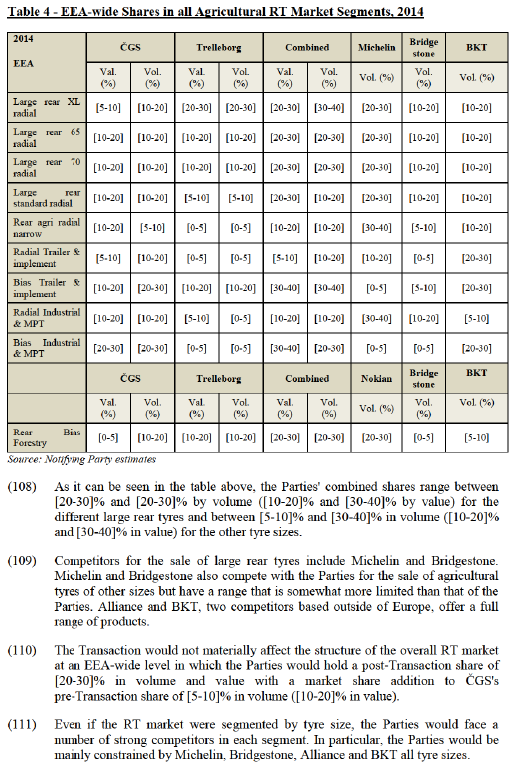
(112) Moreover, the market investigation has pointed out that barriers to the import of tyres into Europe are limited. There are also no barriers preventing other major players from selling in any national markets. The Parties' main competitors (Michelin, Bridgestone, Alliance, BKT) all have RT sales for at least one size of agricultural tyres in each Member State indicating that there is no reason why they could not have sales of other sizes of agricultural tyres in each Member State.
Quality and price tiers – closeness of competition
(113) The findings above in paragraphs (84) - (87) relating to different quality and price tiers in the OEM segment are mirrored in the RT segment. The majority of RT customers that responded to the market investigation are of the view that ČGS and Trelleborg mainly operate in two different tiers and do not consider them to be close competitors. Moreover, a majority of RT customers that responded to the market investigation indicated that if faced with a price increase for Trelleborg tyres they would switch part of their tyre purchases to Michelin or Bridgestone and that in case of price increase of ČGS's Mitas and Mitas Premium brands they would switch part of their purchases to BKT, followed by Firestone, Alliance, and Michelin (Kleber).
(114) Therefore, the Commission considers that Trelleborg and ČGS are not close competitors and that any price increase by Trelleborg post-Transaction would likely to be unprofitable because most RT customers would source part of their requirements from its competitors.
Competitors based outside of the EEA
(115) Compared with the OEM segment, manufacturers outside the EEA have far greater market acceptance in the RT market. The combined market shares of the two main Indian suppliers (BKT and Alliance) are higher at an EEA level in the RT market compared to the OEM segment for 8 of the 10 product segments. (80) This is particularly the case for large rear tyres where both Alliance and BKT have significantly higher shares in the RT market compared to the OEM market showing great levels of customer acceptance.
(116) Therefore, the Commission considers that there are low barriers to import agricultural tyres into the EEA and that tyre manufacturers located outside of the EEA constitute a competitive constraint on the Parties in the RT segment.
New entrants
(117) Continental and Pirelli have both confirmed their intention to enter the European agricultural tyre business for the RT market as well as the OEM market within the next two years. (81) Pirelli in particular intends to initially offer it tyres in the RT segment to gain brand recognition and then try to win sales with OEMs. (82)
(118) Therefore, the Commission considers that Continental and Pirelli once active in the EEA will constitute a competitive constraint on the Parties.
5.3.2. Competitive Assessment
(119) When tyre sizes are taken into account and the markets are considered nationally or regionally, the Transaction gives rise to 191 affected market segments in the RT agricultural tyre market which are analysed below, by country. The market investigation suggests that the market dynamics discussed above apply across each of these markets.
(120) A majority of respondents to the market investigation indicated that the Transaction would have a positive or neutral impact on their business, the trade and prices of agricultural tyres in the EEA. A few RT customers in a number of Member States raised general concerns relating to consolidation and potential higher prices. However, they have also indicated that should Trelleborg increase prices post- Transaction, they would switch part of their purchases of agricultural tyres away from the Parties and to their competitors.
(121) The Commission finds that the Transaction does not give rise to serious doubts as to its compatibility with the internal market in respect of RT agricultural tyres in any Member State.
Austria
(122) The Transaction gives rise to potential affected markets by value or volume in ten product segments, the highest combined share being [40-50]% by volume and [30-40]% by value in Rear Radial XL. When considering sales across all agricultural and forestry tyre segments, BKT will have a similar market position as the merged entity post-Transaction with both having a combined share of [20-30]% by volume. The Transaction results in an increment of less than [0-5]% by value and volume in two potential markets where the effects of the Transaction can be expected to be minimal.

a result of the Transaction is limited ([0-5]%) therefore the effects of the Transaction can be expected to be minimal.
(131) For Bias Industrial and MPT, the combined share was more than [20-30]% in 2014 but there was [sales data]; however Trelleborg did have sales in 2015 giving rise to a projected combined share of [30-40]% by value and [30-40]% by volume with a Trelleborg increment of [0-5]%. Trelleborg's sales amounted to [number of tyres]; ČGS tyre sales in this segment remained the same between 2014 and 2015 therefore it cannot be concluded that Trelleborg's sales came at the expense of ČGS sales.
(132) With regard to Small Agro Gardening Equipment, the Parties would have a combined share of [10-20]% by volume and [20-30]% by value with BKT ([30-40]%) remaining the largest player on the market post-Transaction.
(133) With regard to Front Wheels, the Parties would have a combined share of [20-30]%. BKT however will remain the largest competitor in this segment with [30-40]%, and Alliance is also a strong competitor with [10-20]%.
(134) Of the seven respondents to the market investigation that reported having agricultural RT sales Austria, all reported that they considered that prices for Tier 1, Tier 2 and Tier 3 tyres would remain the same following the Transaction. (83) All respondents considered that the Transaction would either have a neutral or positive impact on their business (84) and on the market for agricultural tyres in the EEA. (85) Moreover, the majority considered that the Transaction would not have an impact on the availability of agricultural tyres in the EEA (86) and that the level of competition on the market would either remain the same or increase as a result of the Transaction. (87)
(135) Given the results of the market investigation in addition to the overall EEA market dynamics described above at paragraphs (106) - (118), the Commission considers that the Transaction would not lead to serious doubts as to its compatibility with the internal market in any potential market in Austria.
Benelux
(136) The Transaction gives rise to potential affected markets by value or volume in eight product segments, the highest combined share being [30-40]% by value and volume in Rear Radial 65 and [20-30]% by volume but [40-50]% by value in small agro gardening equipment.
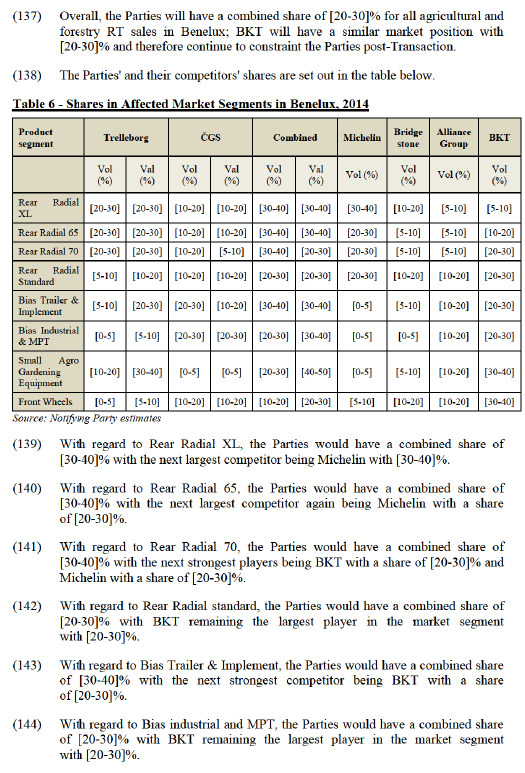
(145) With regard to Small Agro Gardening Equipment, the Parties would have a combined share of [20-30]% by volume (but [40-50]% by value) with BKT remaining the largest player on the market segment by volume with [30-40]%.
(146) With regard to Front Wheels, the Parties would have a combined share of [10-20]% volume and [20-30]% by value. BKT however will remain the largest competitor in this segment with [30-40]% and Alliance is also a strong competitor with [10-20]%.
(147) Of the nine respondents to the market investigation that reported having agricultural RT sales in Belgium, Luxembourg or the Netherlands, two reported that they considered that prices for Tier 1 and Tier 2 tyres may increase as a result of the Transaction while the majority considered that prices would remain the same. (88) Similarly, the majority of respondents considered that the Transaction would have either a neutral or even positive effect on their company and the market for agricultural tyres. (89) The majority considered that the Transaction would not have an impact on the availability of agricultural tyres in the EEA (90) and that the level of competition on the market would either remain the same or increase as a result of the Transaction. (91)
(148) One respondent considered that the Transaction could have a negative impact on the market because of the potential disintermediation of third party distributors for Mitas products in the Benelux as the combined entity would be able to leverage the direct distribution network of Trelleborg. The Commission does not consider this to be an anti-competitive effect of the Transaction, rather a potential distribution efficiency.
(149) Of the other respondents that considered that the Transaction could result in higher prices, both responded that in the event of a 5 – 10% price increase, they would switch a sizable portion of their demand to another supplier, in particular Firestone, BKT and Alliance in response to a price increase for Mitas branded tyres and Michelin in response to a price increase for Trelleborg branded tyres. (92)
(150) Given the results of the market investigation in addition to the overall EEA market dynamics described above at paragraphs (106) - (118), the Commission considers that the Transaction would not lead to serious doubts as to its compatibility with the internal market in any potential market in the Benelux region.

arising as a result of the Transaction is limited ([0-5]%) therefore the effects of the Transaction can be expected to be minimal.
(158) With regard to Bias Industrial and MPT, the Parties would have a combined share of [20-30]% with BKT reaming approximately the same size with a share of [20-30]%. The increment arising as a result of the Transaction is limited ([0-5]%) therefore the effects of the Transaction can be expected to be minimal.
(159) With regard to Small Agro Gardening Equipment the Parties would have a combined share of [30-40]% with BKT being the next largest player with [30-40]%.
(160) With regard to Front Wheels, the Parties would have a combined share of [30-40]% by volume ([50-60]% by value) with the next largest player being BKT with [30-40]%. The increment however is limited ([0-5]%) therefore the effects of the Transaction can be expected to be minimal.
(161) Of the four respondents to the market investigation that reported having agricultural RT sales in Bulgaria, two expect that prices for Tier 1, Tier 2 and Tier 3 tyres will remain the same following the Transaction with another expecting prices to decrease. (93) Similarly, all respondents considered that the Transaction would have either a neutral or positive effect on their company and the market for agricultural tyres. (94) The majority considered that the Transaction would not have an impact on the availability of agricultural tyres in the EEA (95) and none considered that the level of competition on the market would decrease as a result of the Transaction. (96)
(162) Given these factors in addition to the overall EEA market dynamics described above at paragraphs (106) - (118), the Commission considers that the Transaction would not lead to serious doubts as to its compatibility with the internal market in any potential market in Bulgaria.
Croatia
(163) The Transaction gives rise to potential affected markets by value or volume in four product segments, the highest combined share being [20-30]% by volume and [30-40]% by value in bias industrial and MPT.
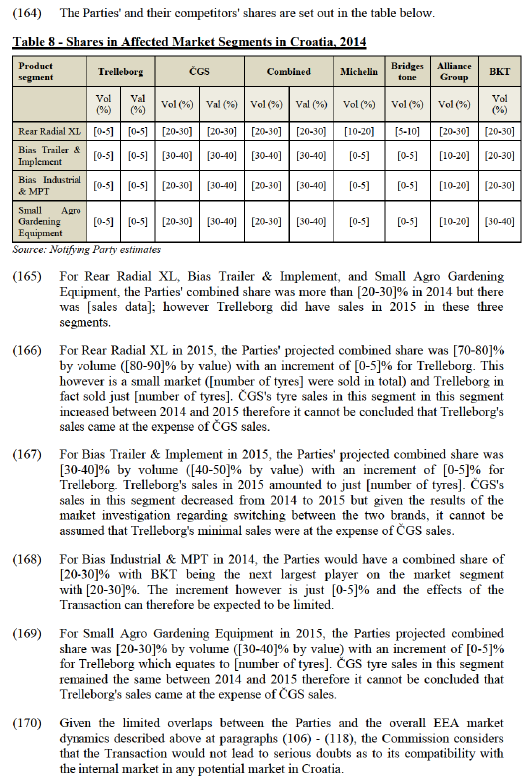
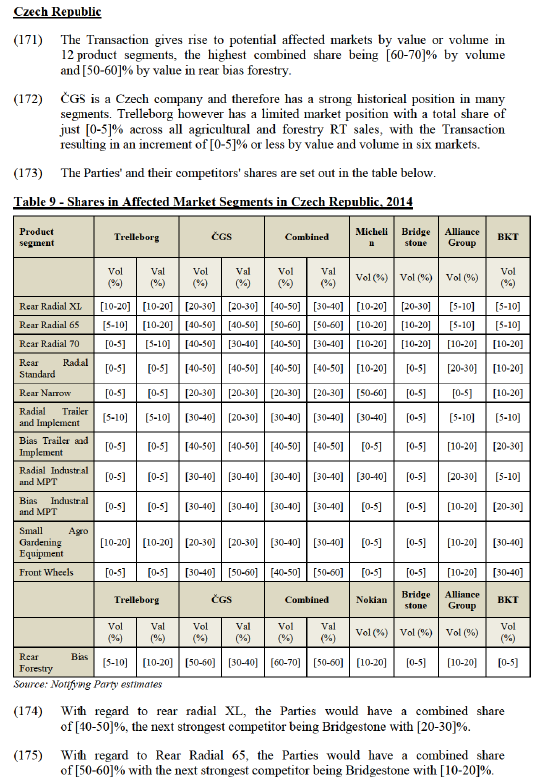
(176) With regard to Rear Radial 70, the Parties would have a combined share of [40-50]% with the next strongest players being Bridgestone and Michelin, each with [10-20]%.
(177) With regard to Rear Radial Standard, the Parties would have a combined share of [40-50]% with the next largest player being Alliance with [20-30]%. The increment however is just [0-5]% and the effects of the Transaction can therefore be expected to be limited.
(178) With regard to Rear Narrow, the Parties would have a combined share of [20-30]% with Michelin remaining market leader with [50-60]%. The increment however is just [0-5]% and the effects of the Transaction can therefore be expected to be limited.
(179) With regard to Radial Trailer & Implement, the Parties would have a combined share of [30-40]% with the next largest player being Michelin with [30-40]%.
(180) With regard to Bias Trailer & Implement, the Parties would have a combined share of [40-50]% with BKT the next largest competitor with [20-30]%. The increment however is just [0-5]% and the effects of the Transaction can therefore be expected to be limited.
(181) With regard to Radial Industrial & MPT the Parties would have a combined share of [30-40]% with Michelin having a similar market position of [30-40]%. The increment however is just [0-5]% and the effects of the Transaction can therefore be expected to be limited.
(182) With regard to Bias Industrial & MPT the Parties would have a combined share of [30-40]% with BKT the next largest competitor with [20-30]%. The increment however is just [0-5]% and the effects of the Transaction can therefore be expected to be limited.
(183) With regard to small agro gardening equipment, the Parties would have a combined share of [30-40]% with the next strongest competitor being BKT with [30-40]%.
(184) With regard to Front wheels the Parties would have a combined share of [40-50]% with BKT the next largest competitor with [30-40]%. The increment however is just [0-5]% and the effects of the Transaction can therefore be expected to be limited.
(185) With regard to rear bias forestry, the Parties would have a combined share of [60-70]% with Nokian having a share of [10-20]%. As described above at para (80), Nokian is by far the clear market leader with regard to forestry tyres in the EEA and can therefore be expected to constrain the merged entity post- Transaction despite the high national shares in the Czech Republic.
(186) Of the seven respondents to the market investigation that reported having agricultural RT sales in the Czech Republic, all considered that the Transaction would have either a neutral or even positive effect on their company or the market
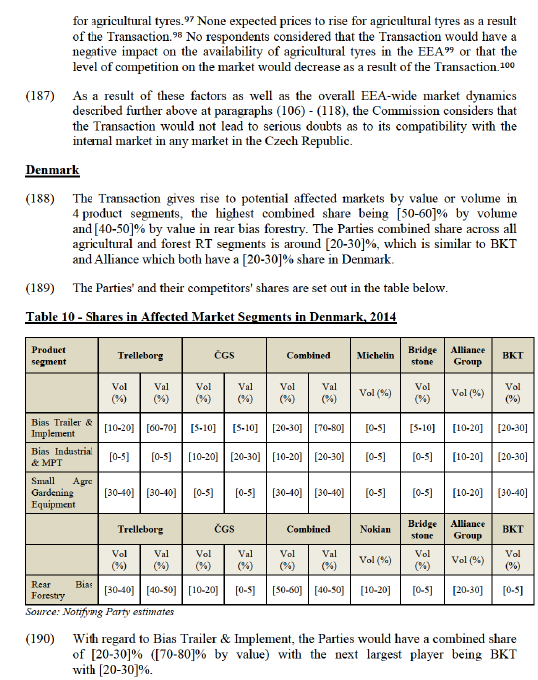
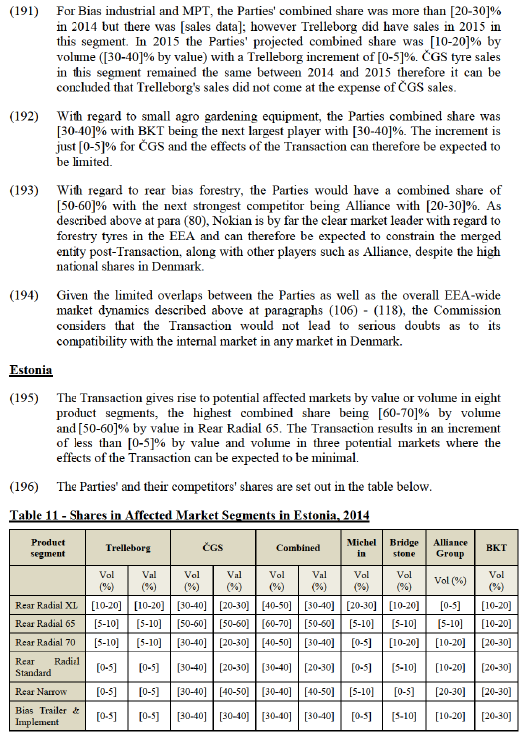
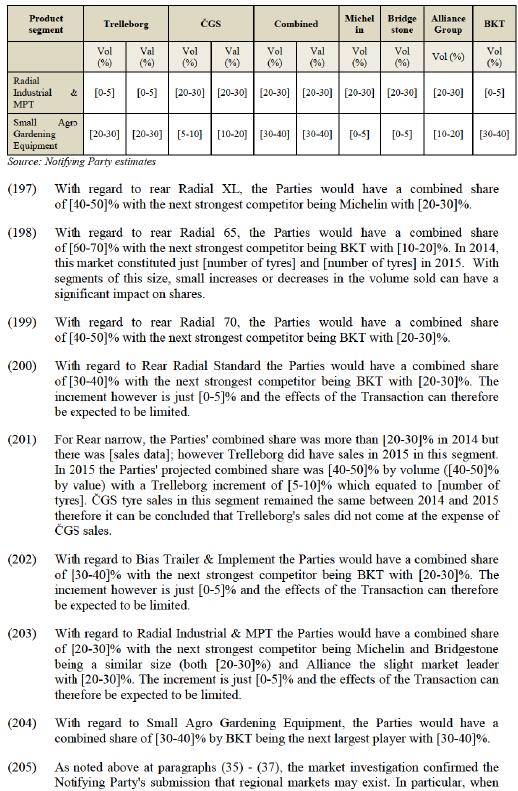
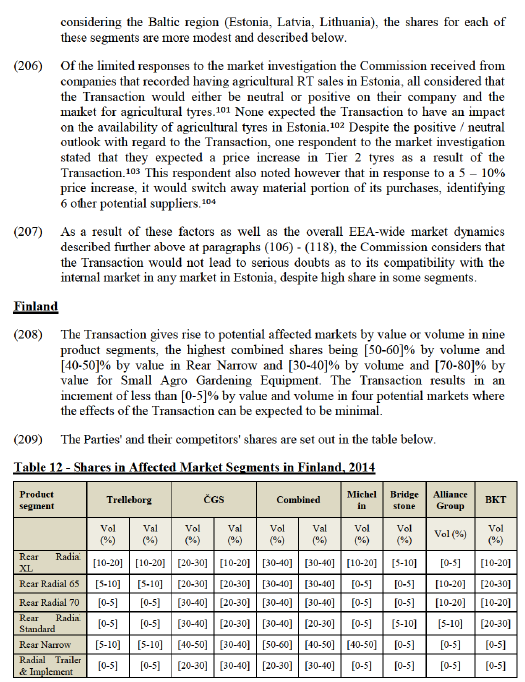
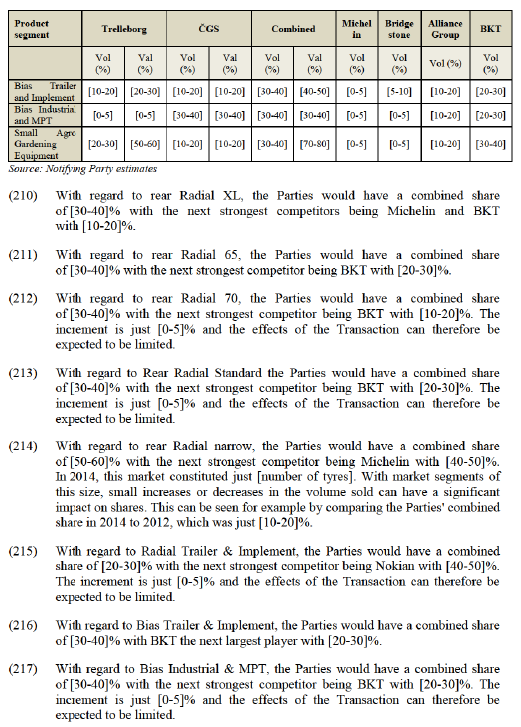
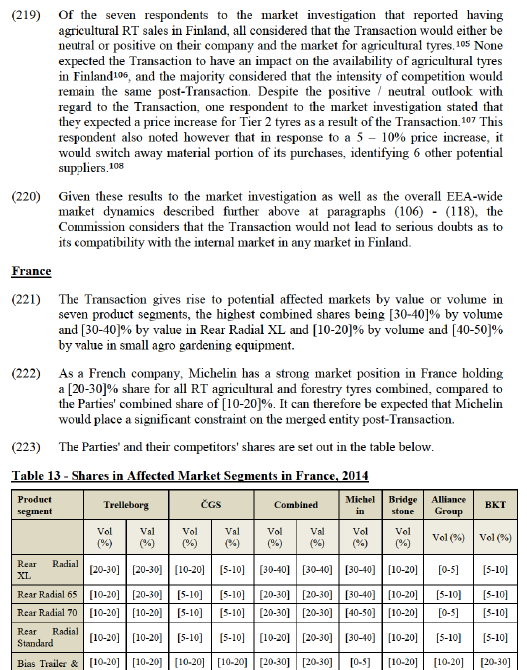
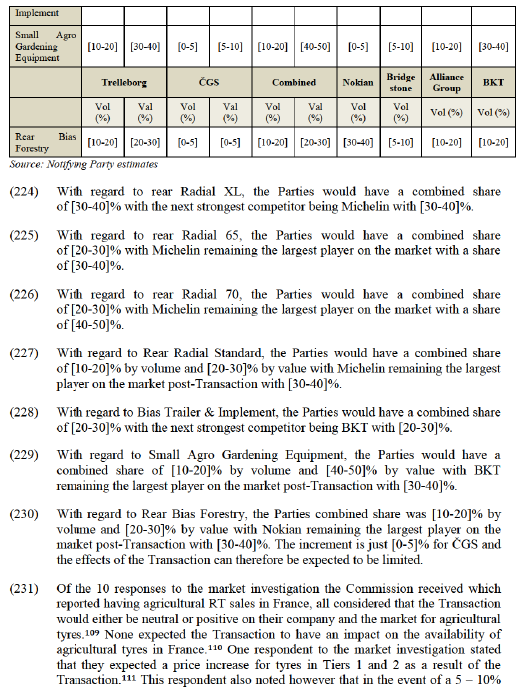
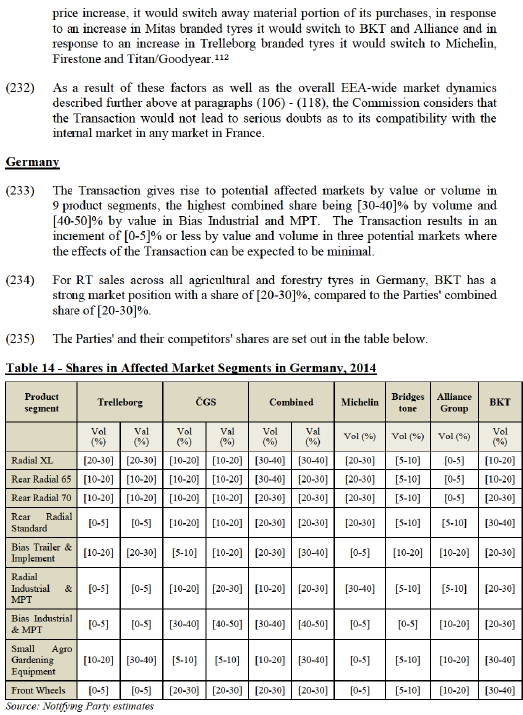
(236) With regard to rear Radial XL, the Parties would have a combined share of [30-40]% with the next strongest competitor being Michelin with [20-30]%.
(237) With regard to rear Radial 65, the Parties would have a combined share of [30-40]% with the next strongest competitor being Michelin with [20-30]%.
(238) With regard to rear Radial 70, the Parties would have a combined share of [20-30]% with Michelin remaining the largest player on the market with a share of [20-30]%.
(239) With regard to rear radial standard, the Parties would have a combined share of [20-30]% with Michelin ([20-30]%) and BKT ([30-40]%) remaining larger than merged entity.
(240) With regard to Bias Trailer & Implement, the Parties would have a combined share of [20-30]% with the next largest player being BKT with [20-30]%.
(241) With regard to Radial Industrial & MPT, the Parties would have a combined share of [10-20]% by volume and [20-30]% by value with Michelin ([30-40]%) and BKT ([20-30]%) both remaining larger than the merged entity post-Transaction. Moreover, the increment is just [0-5]% and the effects of the Transaction can therefore be expected to be limited.
(242) With regard to Bias Industrial & MPT, the Parties would have a combined share of [30-40]% with the next largest player being BKT with [20-30]%. The increment is just [0-5]% and the effects of the Transaction can therefore be expected to be limited.
(243) With regard to small agro gardening equipment, the Parties would have a combined share of [10-20]% by volume and [30-40]% by value with BKT remaining a larger player post-Transaction with [30-40]%.
(244) With regard to Front wheels, the Parties would have a combined share of [20-30]% with BKT remaining the largest player on the market with [30-40]%. The increment is just [0-5]% and the effects of the Transaction can therefore be expected to be limited.
(245) Of the 15 respondents to the market investigation that reported having agricultural RT sales in Germany, two reported that they considered that prices for Tier 1 and Tier 2 tyres would increase as a result of the Transaction while the majority considered that prices would remain the same, or decrease. (113) Similarly, the majority of respondents considered that the Transaction would have either a neutral or positive effect on their company and the market for agricultural tyres (114) and that the level of competition in Germany would either remain the same or increase post- Transaction.
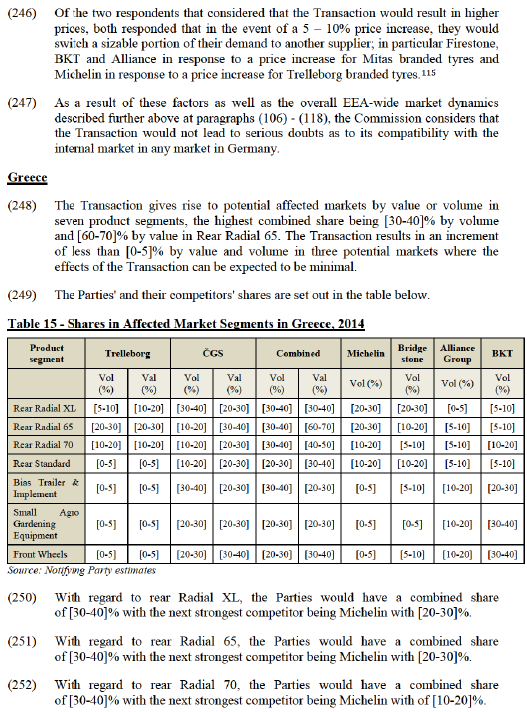
(253) With regard to rear Standard, the Parties would have a combined share of [20-30]% with Michelin and BKT both having strong positions with [10-20]%. Moreover, Trelleborg has an increment of just [0-5]%.
(254) With regard to Bias Trailer & Implement, the Parties would have a combined share of [30-40]%. The next largest player on the market is BKT with [20-30]%. The increment is just [0-5]% and the effects of the Transaction can therefore be expected to be limited.
(255) With regard to Small Agro Gardening Equipment, the Parties would have a combined share of [20-30]%. BKT will remain the largest player on the market post-Transaction with [30-40]%. Moreover, the increment is just [0-5]% and the effects of the Transaction can therefore be expected to be limited.
(256) With regard to Front Wheels, the Parties would have a combined share of [20-30]%. BKT will remain the largest player on the market post-Transaction with [30-40]%. Moreover, the increment is just [0-5]% and the effects of the Transaction can therefore be expected to be limited.
(257) Of the six respondents to the market investigation that reported having agricultural RT sales in Greece, they all reported that they considered prices for Tier 1, Tier 2 and Tier 3 tyres would remain the same or decrease as a result of the Transaction. (116) All respondents considered that the Transaction would either have a neutral or positive impact on their business and on the market for agricultural tyres in the EEA. (117) Moreover, the majority considered that the Transaction would not have an impact on the availability of agricultural tyres in the EEA (118) and that the level of competition in Greece would either remain the same or increase. (119)
(258) As a result of these factors as well as the overall EEA-wide market dynamics described further above at paragraphs (106) - (118), the Commission considers that the Transaction would not lead to serious doubts as to its compatibility with the internal market in any market in Greece.
Hungary
(259) The Transaction gives rise to potential affected markets by value or volume in nine product segments, the highest combined shares being [20-30]% by volume and [30-40]% by value in Rear Radial 65 and [40-50]% by volume and [30-40]% by value for bias trailer & implement. The Transaction results in an increment of less than [0-5]% by value and volume in five potential markets where the effects of the Transaction can be expected to be minimal.
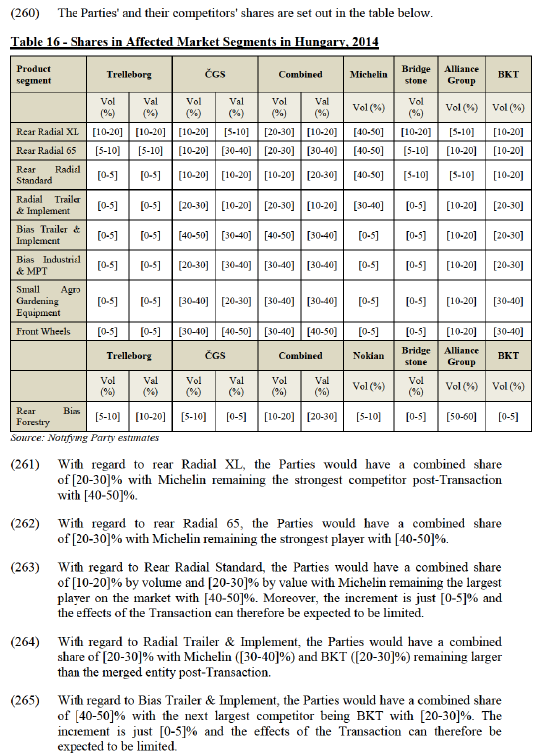
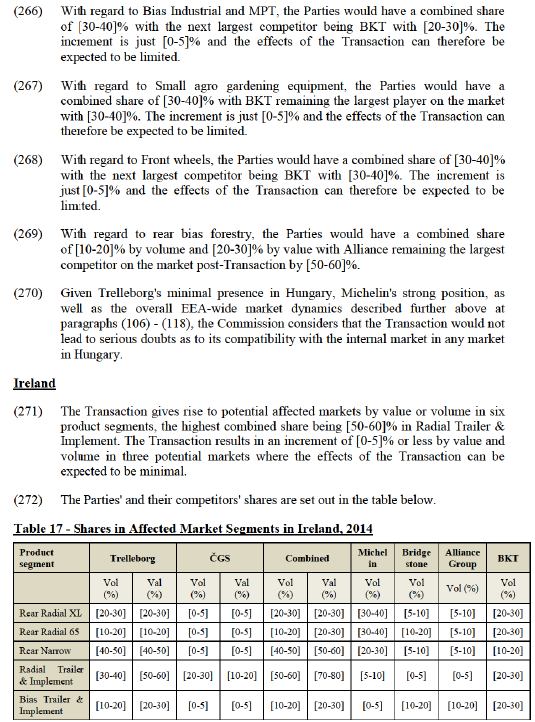

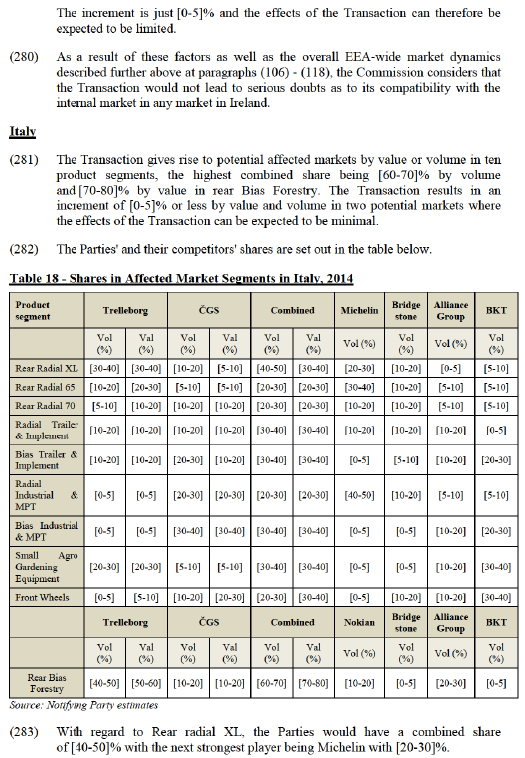
(284) With regard to Rear radial 65, the Parties would have a combined share of [20-30]% with Michelin remaining the strongest player on the market post-Transaction with [30-40]%.
(285) With regard to Rear radial 70, the Parties would have a combined share of [20-30]% with the next strongest player being Michelin with [10-20]%.
(286) With regard to Radial Trailer and Implement, the Parties would have a combined share of [30-40]% with the next strongest player being Alliance with [10-20]%.
(287) With regard to bias Trailer and Implement, the Parties would have a combined share of [30-40]% with the next strongest player being BKT with [20-30]%.
(288) With regard to Radial Industrial & MPT, the Parties would have a combined share of [20-30]% with Michelin remaining the largest competitor post-Transaction with [40-50]%. Moreover, the increment is just [0-5]% and the effects of the Transaction can therefore be expected to be limited.
(289) With regard to Bias Industrial & MPT, the Parties would have a combined share of [30-40]% with the next largest competitor being BKT with [20-30]%. The increment is just [0-5]% and the effects of the Transaction can therefore be expected to be limited.
(290) With regard to Small Agro Gardening Equipment, the Parties would have a combined share of [30-40]% with the next strongest player being BKT with [30-40]%.
(291) With regard to front wheels, the Parties would have a combined share of [20-30]% with BKT remaining the strongest player post-Transaction with [30-40]%.
(292) With regard to Rear Bias Forestry, the Parties would have a combined share of [60-70]% with the next largest player being Alliance with [20-30]%. As described above at para (80), Nokian is by far the clear market leader with regard to forestry tyres in the EEA and can therefore be expected to constrain the merged entity post-Transaction despite the high national shares in Italy.
(293) Of the 12 respondents to the market investigation that reported having sales of agricultural tyres in Italy, one reported that it considered that prices for Tier 1 tyres would increase as a result of the Transaction and two that considered that prices may increase in Tier 2; the majority considered that prices would remain the same or decrease in all three tiers as a result of the Transaction. (120) Similarly, the majority of respondents (11 out of the 12) considered that the Transaction would have either a neutral or even positive effect on their company and the market for agricultural tyres. (121) The same proportion considered that the intensity of competition in Italy would either remain the same or increase post-Transaction.
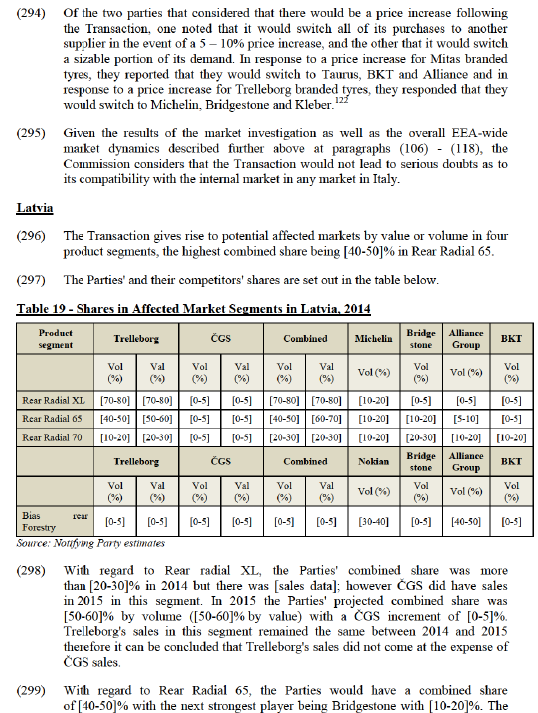
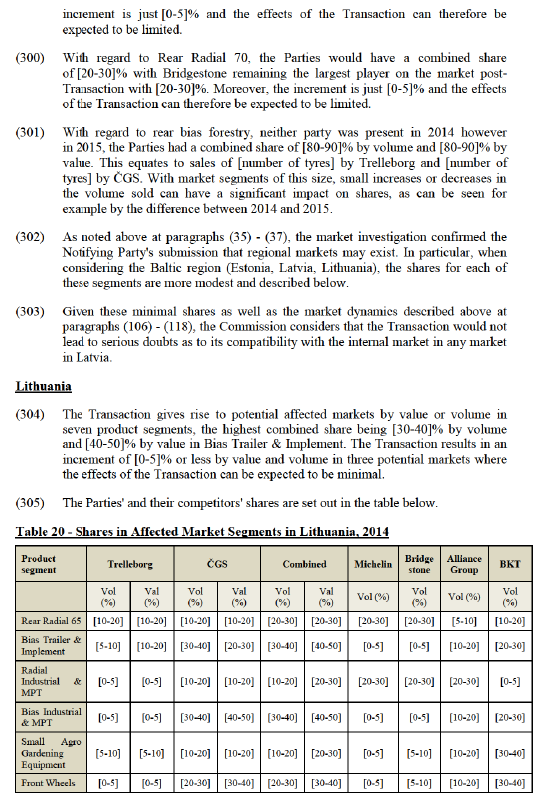
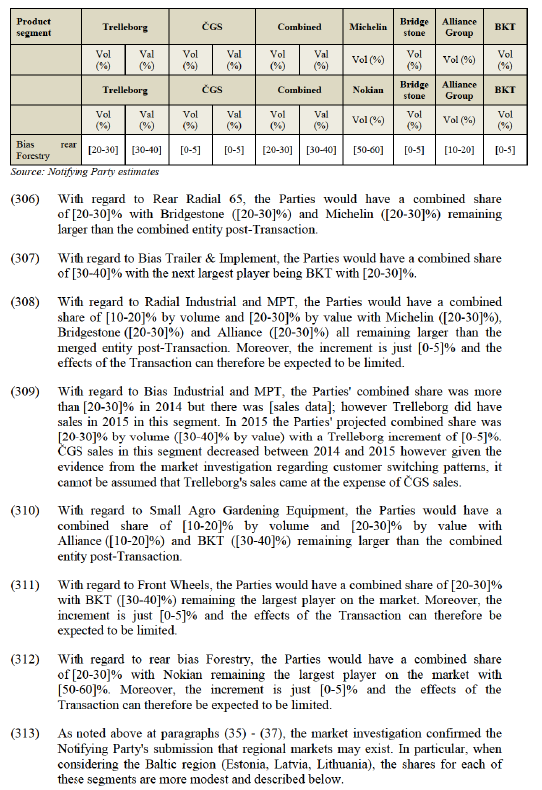
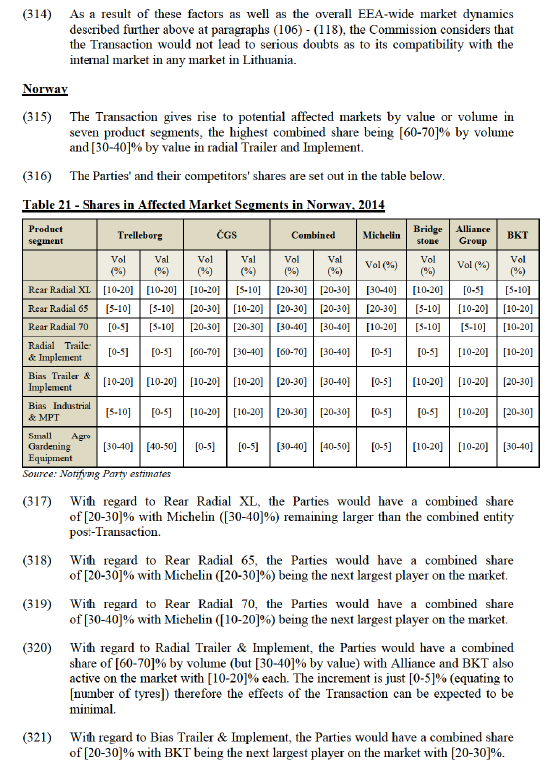
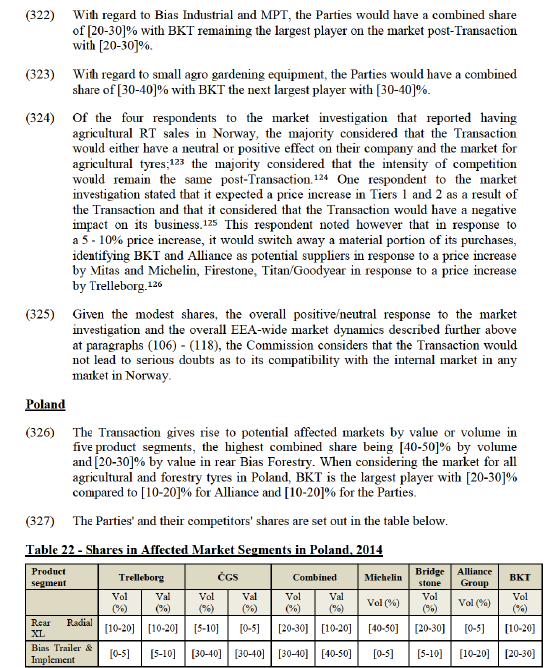
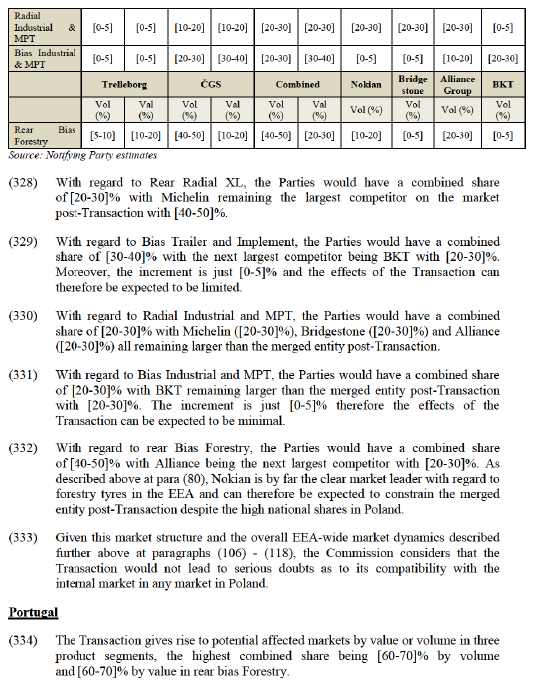
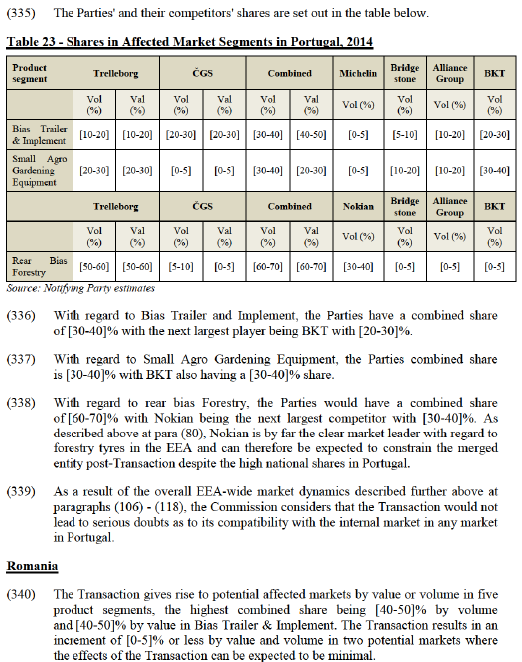
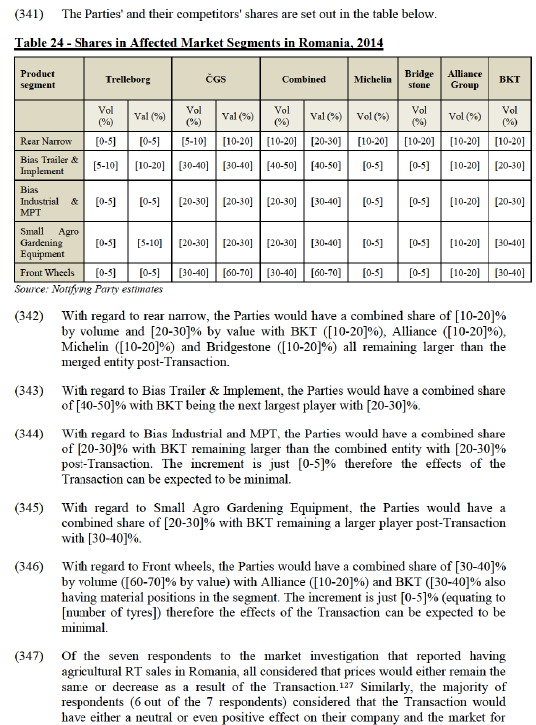
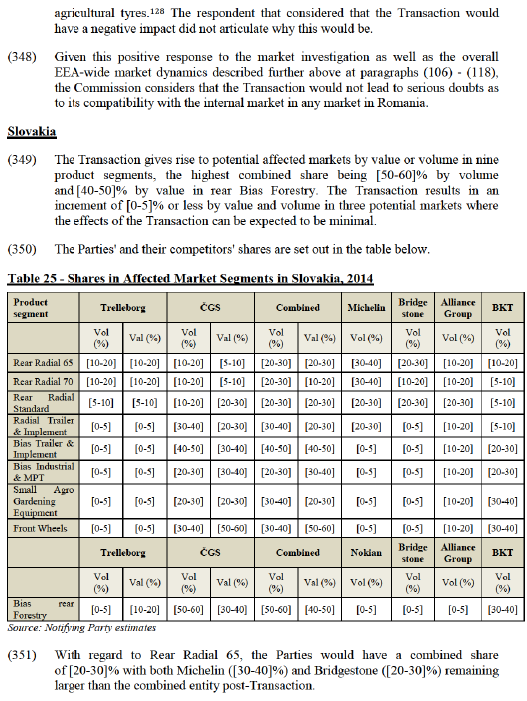
(352) With regard to Rear Radial 70, the Parties would have a combined share of [20-30]% with Michelin ([30-40]%) remaining larger than the combined entity post-Transaction.
(353) With regard to Rear Radial Standard, the Parties would have a combined share of [20-30]% with Bridgestone ([20-30]%) remaining larger than the combined entity post-Transaction.
(354) For radial trailer & implement, the combined share was more than [20-30]% in 2014 but there was [sales data]; however Trelleborg did have sales in 2015 giving rise to a projected share of [40-50]% by value and [50-60]% by volume. ČGS sales in this segment increased between 2014 and 2015 therefore it can therefore be concluded that Trelleborg's sales did not come at the expense of ČGS sales.
(355) With regard to Bias Industrial and MPT, the Parties would have a combined share of [20-30]% with BKT being around the same size as the merged entity post-Transaction with [20-30]%. The increment is just [0-5]% therefore the effects of the Transaction can be expected to be minimal.
(356) With regard to Small Agro Gardening Equipment the Parties would have a combined share of [30-40]% with BKT remaining the same size as the merged entity with [30-40]%. The increment is just [0-5]% therefore the effects of the Transaction can be expected to be minimal.
(357) With regard to Front Wheels the Parties would have a combined share of [30-40]% by volume ([50-60]% by value) with BKT ([30-40]%) and Alliance ([10-20]%) both holding material shares. The increment is just [0-5]% therefore the effects of the Transaction can be expected to be minimal.
(358) With regard to rear bias forestry, the Parties would have a combined share of [50-60]% with BKT the next largest player with [30-40]%. As described above at para (80), Nokian is by far the clear market leader with regard to forestry tyres in the EEA and can therefore be expected to constrain the merged entity post- Transaction despite the high national shares in Slovakia.
(359) Of the ten respondents to the market investigation that reported having agricultural RT sales Slovakia, none expected prices to rise for agricultural tyres as a result of the Transaction. (129) Similarly, the vast majority of respondents considered that the Transaction would have either a neutral or even positive effect on their company and the market for agricultural tyres. (130) Equally, the majority of respondent considered that the Transaction would have no effect on the availability of agricultural tyres (131) and that the intensity of competition would either remain the same or increase as a result of the Transaction. (132)
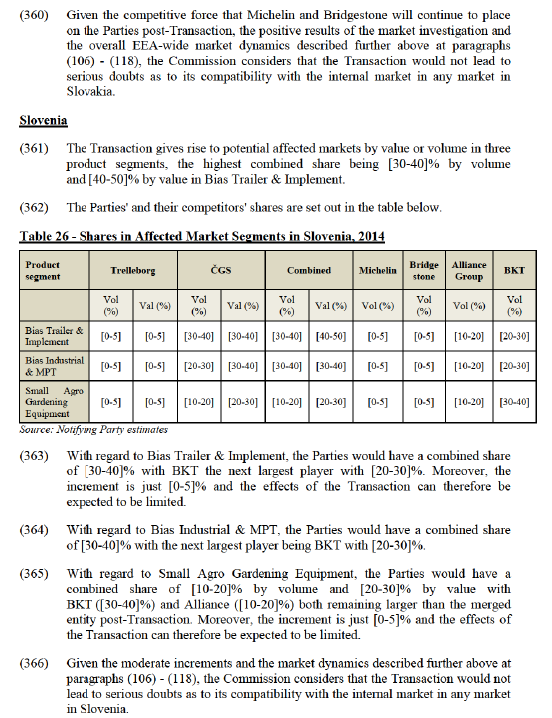
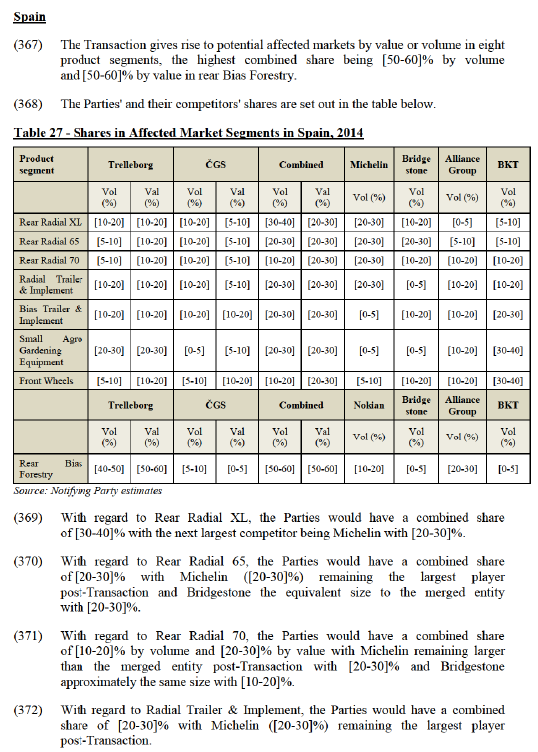
(373) With regard to Bias Trailer & Implement, the Parties would have a combined share of [20-30]% with the next largest competitor being BKT with [20-30]%. Other players on the market collectively also hold [20-30]% of the segment.
(374) With regard to Small Agro Gardening Equipment, the Parties would have a combined share of [20-30]% with BKT ([30-40]%) remaining the largest player post-Transaction.
(375) With regard to front wheels, the Parties would have a combined share of [10-20]% by volume and [20-30]% by value with BKT ([30-40]%), Alliance ([10-20]%) and Bridgestone ([10-20]%) remaining larger than the merged entity post-Transaction.
(376) With regard to rear bias forestry, the Parties would have a combined share of [50-60]% with Alliance being the next largest player with [20-30]%. As described above at para (80), Nokian is by far the clear market leader with regard to forestry tyres in the EEA and can therefore be expected to constrain the merged entity post-Transaction despite the high national shares in Spain.
(377) Of the seven respondents to the market investigation that reported having agricultural RT sales Spain, none expected prices to rise for agricultural tyres as a result of the Transaction. (133) Similarly, all respondents considered that the Transaction would have either a neutral or positive effect on their company and the market for agricultural tyres. (134) Equally, all respondents considered that the Transaction would have no effect on the availability of agricultural tyres (135) and that the intensity of competition would either remain the same or increase as a result of the Transaction. (136)
(378) Given this positive feedback from the market investigation and the overall EEA-wide market dynamics described above at paragraphs (106) - (118), the Commission considers that the Transaction would not lead to serious doubts as to its compatibility with the internal market in any market in Spain.
Sweden
(379) Trelleborg is a Swedish company and therefore has a strong historical position in many segments. CGS has a more limited market position with a total share of [5-10]% across all agricultural and forestry RT sales. Across all segments in Sweden, the combined entity will have a share of [30-40]% with other players also holding strong positions on the market, in particular BKT with [20-30]%.
(380) The Transaction gives rise to potential affected markets by value or volume in eight product segments, the highest combined share being [50-60]% by volume and value in Rear Radial XL.
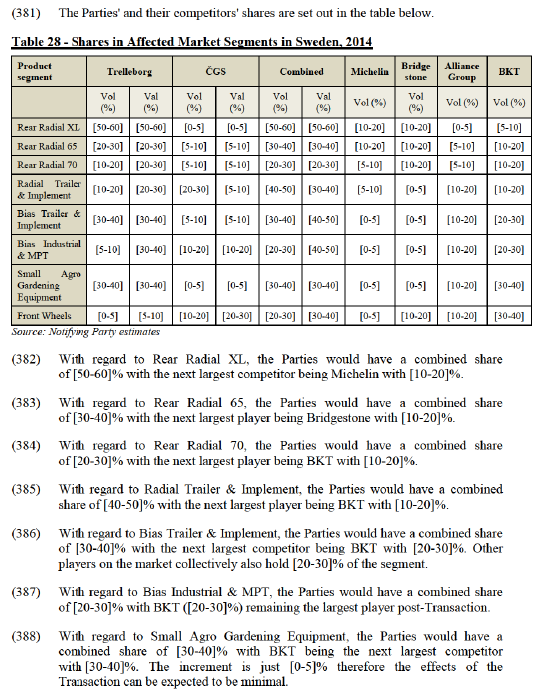
(389) With regard to Front Wheels, the Parties would have a combined share of [20-30]% with BKT remaining the largest competitor post-Transaction with [30-40]%.
(390) Of the six respondents to the market investigation that reported having agricultural RT sales in Sweden, two reported that they considered that prices for Tier 1 tyres may increase as a result of the Transaction and one of these also thought that the price of Tier 2 tyres would increase as a result of the Transaction. The majority considered that prices would remain the same. (137) Similarly, the majority of respondents considered that the Transaction would have either a neutral or even positive effect on their company or the market for agricultural tyres. (138)
(391) Of the respondents that considered that the Transaction could result in higher prices, both responded that in the event of a 5 – 10% price increase, they would switch a sizable portion of their demand to another supplier in particular BKT and Alliance in response to a price increase for Mitas branded tyres and Michelin in response to a price increase for Trelleborg branded tyres. (139)
(392) The majority considered that the Transaction would have no impact on the availability of agricultural tyres (140) and that the intensity of competition would either remain the same or increase as a result of the Transaction. (141)
(393) As a result of these overall positive responses to the market investigation, as well as the market dynamics described further above at paragraphs (106) - (118) the Commission considers that the Transaction would not lead to serious doubts as to its compatibility with the internal market in any market in Sweden.
The UK
(394) The Transaction gives rise to potential affected markets by value or volume in six product segments, the highest combined shares being [20-30]% by volume and [20-30]% by value in Rear Narrow and [20-30]% by volume and [20-30]% by value in Small Agro Gardening Equipment.


(409) With regard to Rear Radial Standard the Parties would have a combined market share of [20-30]% with BKT remaining larger than the merged entity post-Transaction with [20-30]%. The increment is just [0-5]% therefore the effects of the Transaction can be expected to be minimal.
(410) With regard to Radial Industrial & MPT the Parties would have a combined market share of [10-20]% by volume and [20-30]% by value. Michelin ([20-30]%), Bridgestone ([20-30]%) and Alliance ([20-30]%) will all remain larger than the merged entity post-Transaction. Moreover, The increment is just [0-5]% therefore the effects of the Transaction can be expected to be minimal.
(411) With regard to Bias Industrial & MPT the Parties would have a combined market share of [20-30]% with BKT having an equivalent share of [20-30]%. The increment is just [0-5]% therefore the effects of the Transaction can be expected to be minimal.
(412) With regard to Bias Trailer & Implement, the Parties would have a combined share of [30-40]% with the next largest player being BKT with [20-30]%.
(413) With regard to Front Wheels, the Parties would have a combined market share of [20-30]% with BKT remaining larger than the merged entity post-Transaction with [30-40]%. The increment is just [0-5]% therefore the effects of the Transaction can be expected to be minimal.
(414) With regard to Small Agro gardening equipment, the Parties would have a combined share of [20-30]% BKT remaining the largest player post-Transaction with a share of [30-40]%.
(415) Of the seven respondents to the market investigation that reported having agricultural RT sales in the Baltic region, all considered that the Transaction would have either a neutral or positive effect on their company and the market for agricultural tyres. (142) Equally, all respondents considered that the Transaction would have no effect on the availability of agricultural tyres (143) and that the intensity of competition would either remain the same or increase as a result of the Transaction. (144)
(416) Given these results to the market investigation as well as the overall EEA-wide market dynamics described further above at paragraphs (106) - (118),the Commission considers that the Transaction would not lead to serious doubts as to its compatibility with the internal market in any market in the Baltic region.
The UK/Ireland
(417) When considering the UK/Ireland as one market, the Transaction gives rise to potential affected markets by value or volume in six product segments, the highest
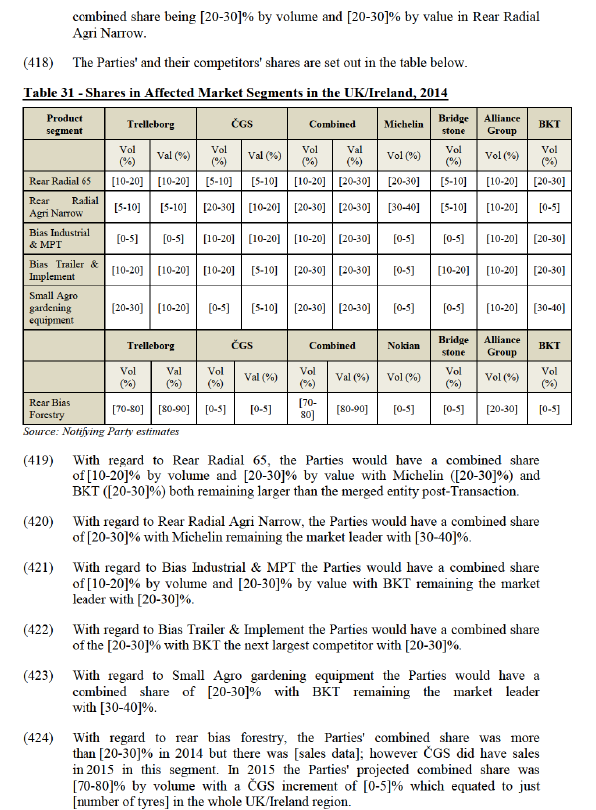
(425) Given these results to the market investigation as well as the overall EEA-wide market dynamics described further above at paragraphs (106) - (118), the Commission considers that the Transaction would not lead to serious doubts as to its compatibility with the internal market in any market in the UK/Ireland region.
5.4. Industrial tyres
(426) Both Parties are active in the supply of tyres for earthmoving vehicles and forklifts. Tyres for earthmoving vehicles and tyres for forklifts are jointly referred to as "industrial tyres". (145)
(427) As regards forklifts, the Parties’ activities overlap only in respect of pneumatic bias tyres on the RT market since CGS is only active in this segment.
(428) As regards earthmoving vehicles, the Parties’ activities overlap only in respect of RT sales of pneumatic bias tyres for loaders and graders since Trelleborg is only active in the RT market and CGS only in respect of pneumatic bias tyres.
(429) On the basis of the narrowest possible market segments, the Transaction gives rise to potential affected markets in respect of: (i) RT pneumatic bias tyres for forklifts; (ii) RT pneumatic bias tyres for loaders; and (iii) RT pneumatic bias tyres for graders.
5.5. Forklift tyres – RT bias pneumatic
5.5.1. Overview of market dynamics
(430) Market dynamics affecting the competitive assessment in the market for tyres for forklifts are similar to those analysed regarding agricultural tyres and tyres for earthmoving vehicles. The findings above in Section 5.3.1 relating to: (i) structure of the market; (ii) differentiation among tyres belonging to different quality and price tiers; (146) (iii) competition from suppliers based outside of the EEA; and (iv) competition from new entrants; are all generally applicable.
Market structure
(431) At an EEA-wide level, the Parties’ combined share for all types of RT forklift tyres (pneumatic and solid) is [20-30]% by volume ([10-20]% by value). The main competitors are Camso ([20-30]% by volume, [20-30]% by value), Continental ([20-30]% by volume, [10-20]% by value), followed by Michelin, Kenda and others. For RT pneumatic bias tyres, the Parties’ combined share is [20-30]% by volume ([10-20]% by value). The main competitors in this segment are Camso ([20-30]% by volume, [30-40]% by value), Continental ([10-20]% by volume, [10-20]% by value) followed by Kenda and others.
Closeness of competition
(432) The Notifying Party argues that the Parties are not close competitors given that the vast majority ([…]%) of Trelleborg’s sales are made in the premium segment where Mitas is not present. Trelleborg’s main competitors in the premium segment are Michelin and Continental.
(433) Trelleborg’s sales in the mid-tier segment relate to sales of pneumatic bias tyres manufactured by third party manufacturers in [supply sources], although they bear the Trelleborg brand. These tyres are produced based on [details of supply conditions]. According to the Notifying Party, this significantly limits the role that Trelleborg can play in terms of competitive constraint on ČGS and other tyre suppliers. Third-party manufacturers on which Trelleborg relies also sell their tyres in the EEA on their own account. (147)
(434) Replies to the market investigation clearly confirmed that the Parties are considered to be present in different tiers.
(435) As Tier 1 suppliers of forklift RT, a majority of customers (and competitors) considered mainly Michelin, Continental, Trelleborg and to some extent also Bridgestone. Mitas was only considered as Tier 1 supplier by a negligible minority of customers. (148)
(436) As Tier 2 suppliers of forklift RT, a majority of customers considered mainly Mitas, and then with an interval BKT, and to some extent Camso and Alliance. A minority of competitors considers as Tier 2 in addition to Mitas and the aforementioned producers also Trelleborg, Continental and Kenda. (149)
(437) As Tier 3 suppliers of forklift RT, a majority of customers (and competitors) considered mainly TVS and Armour (Trelleborg) and few also BKT, Kenda and Alliance. (150)
(438) Given that the majority of respondents to the market investigation clearly indicated that they would not switch between different tiers in case of 5-10% price increases, this indicates that competition effectively takes place within a specific tier (the price differences between Tiers 1 and 2 can amount to up to 15-20%). (151)
(439) Moreover, when these customers were asked if they considered Mitas branded forklift tyres and Trelleborg branded forklift tyres particularly close competitors in the supply of forklift tyres in the EEA, an overwhelming majority replied that they do not consider the Parties to be particularly close competitors. (152) In fact, when customers were asked which brands they perceived as the best alternatives/closest competitors to the Mitas branded forklift tyres in the EEA, the majority cited BKT. (153) Similarly, when asking the same customers which brands they perceived as the best alternatives/closest competitors to the Trelleborg branded forklift tyres in the EEA, the majority cited Continental and Michelin, then Goodyear, Camso and Bridgestone. (154) Finally, when customers were asked if in case of a 5-10% increase in Mitas' forklift tyres they would switch to sourcing from other suppliers, none of them stated they would switch to Trelleborg. The other way around, only a negligible minority cited Mitas as a potential alternative third supplier.
(440) Taking into account the replies to the market investigation, although Trelleborg has some sales also in the mid-tier segment, the Parties are not considered each other's closest competitors on the market for the supply of RT for forklifts.
Existing competitors including competitors based outside of the EEA will continue to constrain the merged entity
(441) A relatively large number of suppliers have started to import pneumatic industrial tyres into the EEA over the past years:
o Double Coin tyres entered by giving exclusive distribution rights to Inter- Sprint Banden B.V. (Netherlands);
o Kenda (Taiwan/China) entered the European market distributing their tyres for forklifts through the distribution network of Starco;
o BKT (India) entered the European market distributing their tyres for forklifts through the network of wholesalers such as Bohnenkamp (Germany). BKT is also a leading manufacturer in the field of industrial tyres, including tyres for earthmoving vehicles. Its focus is almost exclusively on pneumatic tyres.
o TVS (India) entered the European market with the "Eurogrip" brand; and is one of India’s largest industrial conglomerates, active amongst others in the production of industrial tyres.
o Saccon Gomme SpA (Italy) entered the market with the "Ecomega" brand produced in offtake from Chinese manufacturers.
(442) Market rumours suggest that also the following manufacturers may enter the EEA in respect of pneumatic forklift tyres: Ceat (India), Global Rubber Industries (Sri Lanka) and Trident International P Ltd/Traxter (India). Entry often takes place with the help of EEA-based wholesalers/distributors.
5.5.2. Competitive Assessment
Impact on the market
(443) On the basis of the narrowest possible market segmentation, the Parties activities only overlap in respect of RT pneumatic bias tyres. On the narrowest geographic level (national) the Transaction would lead to 15 affected markets. (155) Each of these is assessed in turn below.
(444) The market investigation suggests that the market dynamics discussed above in Section 5.5.1 apply across each of these markets.
(445) A majority of respondents to the market investigation indicated that the Transaction would have either a neutral or positive impact on their business, the market, the intensity of the competition in it, the availability of forklift tyres, as well as on the prices (including the prices in the respective tiers) for RT for forklifts in the EEA (156). Notably, there were no negative responses from any of the customers or competitors, with the exception of one response from a competitor. While one of the Parties' competitors expressed concerns regarding potential price increases and the effect of the Transaction overall, (157) the Commission notes that nearly all responding RT customers indicated that the intensity of competition in the market will remain the same post-Transaction (158) and did not raise any concerns regarding price increases. (159)
(446) The Commission finds that the Transaction does not give rise to serious doubts as to its compatibility with the internal market in respect of RT agricultural tyres in any Member State given that the market structure remains largely the same, the Parties are not viewed as close competitors and multiple competitors from both within the EEA and outside the EEA constrain the Parties.
5.5.2.1. Affected markets for the supply of RT pneumatic bias tyres for forklifts – country by country analysis
Austria
(447) The Parties' combined share in RT pneumatic bias tyres amounts to [20-30]% by volume and [10-20]% by value. Competitors include Camso ([30-40]% by volume, [40-50]% by value), Continental ([10-20]% by volume and [10-20]% by value), followed by Kenda and others.
(448) The Transaction results in a market share increment of [5-10]% by volume and [5-10]% by value.
(449) The combined entity will not be able to profitably increase prices since it will be constrained by numerous competing manufacturers that are present in Austria such as Camso, Continental, Michelin, Kenda and others, with Camso's market share being in fact twice as large as the combined entity.
(450) Notably, no negative replies have been received from the market investigation from forklift RT customers from Austria.
(451) Therefore, taking into account the relatively low horizontal overlap, the presence of several other competitors as well as the overall market dynamics described above in Section 5.5.1 and the results of the market investigation, the Commission considers that the Transaction would not lead to serious doubts as to its compatibility with the internal market in Austria.
Bulgaria
(452) The Parties' combined share in RT pneumatic bias tyres amounts to [50-60]% by volume and [40-50]% by value. Competitors include Kenda ([10-20]% by volume, [20-30]% by value), Camso ([5-10]% by volume and [10-20]% by value), followed by Continental and others.
(453) The Transaction results in market share increment of maximum [10-20]% by value (and [10-20]% by volume), when looking at the market shares comprised in all 3 tiers.
(454) However, due to the fact that, as explained above in paragraphs (432) - (440), Trelleborg and Mitas largely focus on different market segments, their activities are highly complementary and the effects on competition much more limited than what these shares suggest.
(455) The combined entity will be constrained by a large number of suppliers that are also present in Bulgaria such as Continental, Camso, Kenda, Starco and Toronero. All these suppliers have a material supply share at the level of the EEA which in some instances is even larger than the one of the combined entity. This shows that they could easily increase their share in Bulgaria at the expense of the combined business in the event of an attempt to increase prices. In spite of its relatively significant supply share in Bulgaria as far as pneumatic bias RT for forklifts are concerned, the combined entity would therefore not be able to profitably increase prices post-Transaction.
(456) Notably, no negative replies have been received from the market investigation from forklift RT customers from Bulgaria.
(457) Therefore, taking into account the presence of several other competitors as well as the overall market dynamics described above in Section 5.5.1 and the results from the market investigation, the Commission considers that the Transaction would not lead to serious doubts as to its compatibility with the internal market in Bulgaria.
Croatia
(458) The Parties combined share in RT pneumatic bias tyres amounts to [50-60]% by volume and [40-50]% by value. Competitors include Camso ([10-20]% by volume, [10-20]% by value), Continental ([10-20]% by volume and [10-20]% by value), followed by Kenda and others.
(459) The Transaction results in a market share increment of [20-30]% by value and [20-30]% by volume.
(460) However, as explained above in paragraphs (432) - (440), the combined shares overstate the actual overlap between the Parties’ activities given the highly complementary nature of their offering in this area (Trelleborg is mainly focusing on the premium segment where it generates […]% of its sales in the EEA, whilst Mitas is only active in mid-range).
(461) In any event, the combined entity will be constrained by a large number of suppliers that are also present in Croatia such as Continental, Camso, Kenda, Marangoni and Italmatic. All these suppliers have a material supply share at the level of the EEA which in some instances is even larger than the one of the combined entity. This shows that they could easily increase their share in Croatia at the expense of the combined business in the event of an attempt to increase prices. In spite of its relatively significant supply share in Croatia in the market/segment, the combined entity would therefore not be able to profitably increase prices post-Transaction.
(462) Notably, no negative replies have been received from the market investigation from forklift RT customers from Croatia.
(463) Therefore, taking into account the presence of several other competitors as well as the overall market dynamics described above in Section 5.5.1 and the results from the market investigation, the Commission considers that the Transaction would not lead to serious doubts as to its compatibility with the internal market in Croatia.
Czech Republic
(464) The Parties combined share in RT pneumatic bias tyres amounts to [50-60]% by volume and [30-40]% by value. Competitors include Camso ([20-30]% by volume, [20-30]% by value), Continental ([10-20]% by volume and [20-30]% by value), followed by Kenda and others.
(465) The Transaction results in a market share increment of [5-10]% by value and [5-10]% by volume.
(466) The relatively high market share of ČGS results from ČGS historical position on the domestic market. However, as explained above in paragraphs (432) - (440), these percentages overstate the effects on competition due to the complementary nature of the Parties’ activities in this area.
(467) In any event, the combined entity will be constrained by a large number of suppliers that are also present in the Czech Republic such as Continental, Camso and Kenda. All these suppliers have a material supply share at the level of the EEA which in some instances is even larger than the one of the combined entity. This shows that they could easily increase their share in the Czech Republic at the expense of the combined business in the event of an attempt to increase prices. In spite of its relatively significant supply share in the Czech Republic, the combined entity would therefore not be able to profitably increase prices post-Transaction.
(468) Notably, no negative replies have been received from the market investigation from forklift RT customers from the Czech republic.
(469) Therefore, taking into account the presence of several other competitors as well as the overall market dynamics described above in Section 5.5.1 and the results from the market investigation, the Commission considers that the Transaction would not lead to serious doubts as to its compatibility with the internal market in the Czech republic.
Denmark
(470) The Parties combined share in RT pneumatic bias tyres amounts to [20-30]% by volume and [20-30]% by value. Competitors include Camso ([30-40]% by volume, [30-40]% by value), followed by Kenda ([10-20]% by volume, [10-20]% by value) and Continental ([10-20]% by both volume and value) and others.
(471) The increment brought about the Transaction is negligible ([0-5]% by volume and value), since ČGS position on the Danish market is rather limited.
(472) In any event, the combined entity will not be able to profitably increase prices since it will be constrained by numerous competing manufacturers that are present in Denmark such as Camso, Continental, Michelin, Kenda and others. The supply share of these competitors at the EEA level is often in the same order of magnitude as the share of the combined business and sometimes even larger (Camso's market share is higher than the Parties' combined market share). This shows that they could easily increase their share in Denmark in case the combined entity attempts to increase prices.
(473) Notably, no negative replies have been received from the market investigation from forklift RT customers from Denmark.
(474) Therefore, taking into account the negligible increment brought about by the Transaction, the presence of several other competitors as well as the overall market dynamics described above in Section 5.5.1 and the results of the market investigation, the Commission considers that the Transaction would not lead to serious doubts as to its compatibility with the internal market in Denmark.
Finland
(475) The Parties combined share in RT pneumatic bias tyres amounts to [20-30]% by volume and only [10-20]% by value. Competitors include Kenda ([30-40]% by volume, [30-40]% by value), Camso ([20-30]% by volume, [30-40]% by value), followed by Continental and others.
(476) Indeed, the increment is very small ([5-10]% or less) and the combined share remains clearly below [30-40]%. Also, the Transaction would lead to a marginally horizontally affected market only if based on volume, not value. The competitive landscape will accordingly hardly change.
(477) The combined entity will be constrained by several competitors including in particular Continental, Camso, Kenda, Maxam and Nokian. Kenda's and Camso's market shares will be much higher than that of the combined entity.
(478) Notably, no negative replies have been received from the market investigation from forklift RT customers from Finland.
(479) Therefore, taking into account the limited increment brought about by the Transaction (especially in terms of value), the presence of several other competitors as well as the overall market dynamics described above in Section 5.5.1 and the results of the market investigation, the Commission considers that the Transaction would not lead to serious doubts as to its compatibility with the internal market in Finland.
Italy
(480) The Parties combined share in RT pneumatic bias tyres amounts to [20-30]% by volume and [10-20]% by value. Competitors include Camso ([20-30]% by volume, [20-30]% by value), Continental ([20-30]% by volume, [20-30]% by value), followed by Kenda and others.
(481) With regard to pneumatic RT for forklifts (bias only), the overlap is limited. Indeed, the increment is relatively small ([10-20]%/[0-5]%) and the combined share remains clearly below [30-40]%. The competitive landscape will accordingly not substantially change.
(482) In any event, the combined entity will be constrained by a large number of suppliers that are also present in Italy such as Continental, Camso, Kenda, Marangoni, TVS, BKT and Ecomega. All these suppliers have a material supply share at the level of the EEA which in some instances is even larger than the one of the combined entity. This shows that they could easily increase their share in Italy at the expense of the combined business in the event of an attempt to increase prices. The combined entity would therefore not be able to profitably increase prices in Italy post-Transaction.
(483) Notably, no negative replies have been received from the market investigation from forklift RT customers from Italy.
(484) Therefore, taking into account the negligible increment brought about by the Transaction with regard to RT for forklifts (pneumatic and solid) and the relatively small increment brought about by the Transaction with regard to bias pneumatic forklift RT in terms of value, the presence of several other competitors as well as the overall market dynamics described above in Section 5.5.1 and the results of the market investigation, the Commission considers that the Transaction would not lead to serious doubts as to its compatibility with the internal market in Italy.
Lithuania
(485) The Parties combined share in RT pneumatic bias tyres amounts to [10-20]% by volume and [20-30]% by value. Competitors include Camso ([30-40]% by volume, [30-40]% by value), Kenda ([10-20]% by volume, [10-20]% by value), followed by Continental and others.
(486) The overlap is however limited. Indeed, the increment is [5-10]% or less by both volume and value with respect to the supply of bias pneumatic forklift RT. Also, the combined share is moderate, leading to only marginally affected horizontal markets. The competitive landscape will accordingly hardly change.
(487) The combined entity will be constrained by several competitors including in particular Continental, Camso, Kenda and Michelin. Camso will remain number one on the Lithuanian market.
(488) Notably, no negative replies have been received from the market investigation from forklift RT customers from Lithuania.
(489) Therefore, taking into account the negligible increment brought about by the Transaction, the presence of several other competitors as well as the overall market dynamics described above in Section 5.5.1 and the results of the market investigation, the Commission considers that the Transaction would not lead to serious doubts as to its compatibility with the internal market in Lithuania.
Netherlands
(490) The Parties combined share in RT pneumatic bias tyres amounts to [10-20]% by volume and [20-30]% by value. Competitors include Camso ([30-40]% by volume, [20-30]% by value), Continental ([20-30]% by volume, [20-30]% by value), followed by Kenda and others.
(491) The overlap is however very limited in this segment. Indeed, the increment is very small (less than [0-5]%). The competitive landscape will accordingly hardly change.
(492) The combined entity will be constrained by several competitors including in particular Continental, Camso, Kenda and Michelin.
(493) Notably, no negative replies have been received from the market investigation from forklift RT customers from Netherlands
(494) Therefore, taking into account the negligible increment brought about by the Transaction, the presence of several other competitors as well as the overall market dynamics described above in Section 5.5.1 and the results of the market investigation, the Commission considers that the Transaction would not lead to serious doubts as to its compatibility with the internal market in Netherlands.
Poland
(495) The Parties combined share in RT pneumatic bias tyres amounts to [40-50]% by volume and [30-40]% by value. Competitors include Camso ([20-30]% by volume, [20-30]% by value), Kenda ([10-20]% by volume, [20-30]% by value), followed by Continental and others.
(496) The Transaction results in market share increment of [10-20]% by volume and [10-20]% by value.
(497) As explained above in paragraphs (432) - (440), the combined shares largely overstate the actual overlap between the Parties’ activities given the highly complementary nature of their offering.
(498) In any event, the combined entity will be constrained by a large number of suppliers that are also present in Poland such as by Continental, Camso, Kenda, Kabat, BKT and Stomil. All these suppliers have a material supply share at the level of the EEA which in some instances is even larger than the one of the combined entity. This shows that they could easily increase their share in Poland at the expense of the combined business in the event of an attempt to increase prices. In spite of its relatively significant supply share in Poland, in particular as far as bias RT for forklifts are concerned, the combined entity would therefore not be able to profitably increase prices post-Transaction.
(499) Notably, no negative replies have been received from the market investigation from forklift RT customers from Poland.
(500) Therefore, taking into account the presence of several other competitors as well as the overall market dynamics described above in Section 5.5.1 and the results of the market investigation, the Commission considers that the Transaction would not lead to serious doubts as to its compatibility with the internal market in Poland.
Romania
(501) The Parties combined share in RT pneumatic bias tyres amounts to [20-30]% by volume and [10-20]% by value. Competitors include Continental ([20-30]% by volume, [20-30]% by value), Camso ([10-20]% by volume, [10-20]% by value), followed by Kenda and others.
(502) The overlaps in Romania are fairly limited. Indeed, the Transaction results in market share increment of [5-10]% and less by both volume and value. The Transaction results only in marginally horizontally affected market. The competitive landscape will accordingly hardly change.
(503) In any event, the combined entity will be constrained by a large number of suppliers that are also present in Poland such as Continental, Camso, Kenda, Global Rubber Industries and Magna. All these suppliers have a material supply share at the level of the EEA which in some instances is even larger than the one of the combined entity. This shows that they could easily increase their share in Romania at the expense of the combined business in the event of an attempt to increase prices. In spite of its relatively significant supply share in Romania in the market/segment, the combined entity would therefore not be able to profitably increase prices post-Transaction-.
(504) Notably, no negative replies have been received from the market investigation from forklift RT customers from Romania.
(505) Therefore, taking into account the marginal horizontal overlap, presence of several other competitors as well as the overall market dynamics described above in Section 5.5.1 and the results of the market investigation, the Commission considers that the Transaction would not lead to serious doubts as to its compatibility with the internal market in Romania.
Slovakia
(506) The Parties combined share in RT pneumatic bias tyres amounts to [30-40]% by volume and [10-20]% by value. Competitors include Camso ([20-30]% by volume, [20-30]% by value), Continental ([10-20]% by volume, [10-20]% by value), followed by Kenda ([10-20]% by volume, [10-20]% by value), and others.
(507) The overlap is marginal. Indeed, the increment is very small ([0-5]% by both volume and value). The competitive landscape will accordingly hardly change.
(508) The combined entity will be constrained by a large number of suppliers that are also present in Slovakia such as Continental, Camso, Kenda, BKT and Kabat. All these suppliers have a material supply share at the level of the EEA which in some instances is even larger than the one of the combined entity. This shows that they could easily increase their share in Slovakia at the expense of the combined business in the event of an attempt to increase prices. In spite of its relatively significant supply share in the Slovakia in the market/segment, the combined entity would therefore not be able to profitably increase prices post-Transaction.
(509) Notably, no negative replies have been received from the market investigation from forklift RT customers from Slovakia.
(510) Therefore, taking into account the presence of several other competitors as well as the overall market dynamics described above in Section 5.5.1 and the results of the market investigation, the Commission considers that the Transaction would not lead to serious doubts as to its compatibility with the internal market in Slovakia.
Slovenia
(511) The Parties combined share in RT pneumatic bias tyres amounts to [20-30]% by volume and only [10-20]% by value (affected market only arises on the basis of volume). Competitors include Camso ([20-30]% by volume, [20-30]% by value), Kenda ([10-20]% by volume, [10-20]% by value), followed by Continental ([10-20]% by volume, [10-20]% by value), and others.
(512) The Transaction results in small market share increments of [5-10]% or less. The combined share is relatively low ([10-20]/[20-30]%). The competitive landscape will therefore not substantially change.
(513) The combined entity will be constrained by a large number of suppliers that are also present in Slovenia such as Continental, Camso, Kenda, Marangoni, Ecomega and Kabat. All these suppliers have a material supply share at the level of the EEA which in some instances is even larger than the one of the combined entity. This shows that they could easily increase their share in Slovenia at the expense of the combined business in the event of an attempt to increase prices. In spite of its relatively significant supply share in Slovenia in the market/segment, the combined entity would therefore not be able to profitably increase prices post-Transaction.
(514) Notably, no negative replies have been received from the market investigation from forklift RT customers from Slovenia.
(515) Therefore, taking into account the relatively low increment brought about by the Transaction, the marginally affected horizontal market, the presence of several other competitors as well as the overall market dynamics described above in Section 5.5.1 and the results of the market investigation, the Commission considers that the Transaction would not lead to serious doubts as to its compatibility with the internal market in any of the markets in Slovenia.
Spain
(516) The Parties combined share in RT pneumatic bias tyres amounts to [20-30]% by volume and [10-20]% by value (affected market only arises based on volume). Competitors include Camso ([30-40]% by volume, [30-40]% by value), Continental ([10-20]% by volume, [10-20]% by value), followed by Kenda ([0-5]% by volume, [5-10]% by value), and others.
(517) The overlap in Spain is fairly limited. The Transaction results in small market share increment of [5-10]% and the combined share only leads to marginally horizontally affected markets. The competitive landscape will accordingly not substantially change.
(518) The combined entity will be constrained by a large number of suppliers that are also present in Spain such as Continental, Camso, Kenda, Alliance and BKT. All these suppliers have a material supply share at the level of the EEA which in some instances is even larger than the one of the combined entity. This shows that they could easily increase their share in Spain at the expense of the combined business in the event of an attempt to increase prices. In spite of its relatively significant supply share in Spain in the market/segment, the combined entity would therefore not be able to profitably increase prices post-Transaction.
(519) Notably, no negative replies have been received from the market investigation from forklift RT customers from Spain.
(520) Therefore, taking into account the relatively low increment brought about by the Transaction, the marginally horizontally affected market, the presence of several other competitors as well as the overall market dynamics described above in Section 5.5.1 and the results of the market investigation, the Commission considers that the Transaction would not lead to serious doubts as to its compatibility with the internal market in any of the markets in Spain.
Norway
(521) The Parties combined share in RT pneumatic bias tyres amounts to [20-30]% by volume and [20-30]% by value. Competitors include Camso ([10-20]% by volume, [20-30]% by value), Kenda ([10-20]% by volume, [20-30]% by value), Continental ([10-20]% by volume, [10-20]% by value) and others.
(522) The overlap is however very limited. Indeed, the increment is negligible (less than [0-5]%). Also, the Transaction would lead to a marginally horizontally affected market. The competitive landscape will accordingly hardly change.
(523) The combined entity will be constrained by several competitors including in particular Continental, Camso, Michelin, Kenda and others. Camso's market share will be higher than that of the combined entity.
(524) Notably, no negative replies have been received from the market investigation from forklift RT customers from Norway.
(525) Therefore, taking into account the limited increment brought about by the Transaction (especially in terms of value), the marginally horizontally affected market, the presence of several other competitors as well as the overall market dynamics described above in Section 5.5.1 and the results of the market investigation, the Commission considers that the Transaction would not lead to serious doubts as to its compatibility with the internal market in Norway.
5.5.3. Conclusion
(526) Based on the above country-by-country analysis and the considerations discussed above in Sections 5.5.1 and 5.5.2, the Commission also concludes that the Transaction is unlikely to give rise to competition concerns in the supply of RT pneumatic bias tyres for forklifts in each of the national markets that are affected by the Transaction, and therefore does not raise serious doubts as to its compatibility with the internal market in any of these markets.
5.6. Earthmoving tyres – RT pneumatic bias tyres for loaders and graders
5.6.1. Overview of market dynamics
(527) Market dynamics affecting the competitive assessment in the market for earthmoving vehicles are similar to those analysed above regarding agricultural tyres and tyres for forklifts. The findings above relating to: (i) structure of the market; (ii) differentiation among tyres belonging to different quality and price tiers; and (iii) competition from suppliers based outside of the EEA are all generally applicable.
Market structure
(528) The Parties have provided market size, sales and market share data for 2015 for the various segments for tyres for earthmoving vehicles based both on volume and value.
(529) On an EEA-wide level, the Parties’ combined share in respect of pneumatic bias tyres for loaders amounts to [20-30]% by volume and [30-40]% by value (with an increment of [0-5]%). Competitors include Bridgestone ([10-20]% by volume, [10-20]% by value), Goodyear ([10-20]% by volume, [10-20]% by value) with many others making up the rest of the sales in this segment. The category 'others' includes BKT (around [10-20]% in value) and Alliance (around [10-20]% in value).
(530) As regards pneumatic bias tyres for graders (the other area of overlap), the Parties’ combined share amounts to a mere [5-10]% by volume and [10-20]% by value at the EEA-level. Competitors include Bridgestone ([5-10]% by volume, [10-20]% by value), Goodyear ([0-5]% by volume, [5-10]% by value) with many others making up the rest of the sales in this segment. The category 'others' is mainly composed of importers such as BKT (around [20-30]% in value) and Alliance (around [10-20]% in value).
Quality and price tiers – Closeness of competition
(531) Given that Trelleborg mainly produces solid tyres for earthmoving vehicles rather than pneumatic tyres and ČGS only produces pneumatic tyres, the activities of the Parties overlap only to a minimal extent. Trelleborg’s sales in respect of pneumatic tyres are marginal (amounting to EUR […] in 2015). Moreover, for pneumatic tyres, Trelleborg relies on third-party manufacturers. These tyres have been designed and developed by [supply sources] and do not bear the Trelleborg name as they do not qualify as premium tyres in terms of quality and performance. They are just marked with Trelleborg's triangles to show that they are endorsed by Trelleborg. [Supply sources] also sells their tyres in the EEA on their own account ([supply sources]).
(532) As with agricultural and forklift tyres, different quality and price tiers also exist in respect of earthmoving tyres. Replies to the market investigation support this finding. (160)
(533) According to the Notifying Party, ČGS is present in the mid-range (Mitas) and economy range (Cultor). Trelleborg is only active in the mid-range segment through the [supply sources] branded tyres. According to the Notifying Party, [supply sources] is, however, considered a lower-end mid-tier brand compared to ČGS’ higher-end mid-tier Mitas brand. The Parties submit that other suppliers like BKT, Alliance and Magna Tyres may be considered close competitors to Mitas, rather than the [supply sources] brand sold by Trelleborg.
(534) When asked about who they consider the closest competitor to Mitas, only one of the respondents indicated Trelleborg ([supply sources] branded) tyres as being the closest competitor to Mitas tyres. (161)
(535) Based on the above, the Commission considers that Trelleborg and ČGS are not close competitors in the earthmoving vehicles tyres segment. Any potential price increase by Trelleborg post-Transaction would likely be unprofitable because most RT customers would source part of their requirements from its competitors.
Existing strong competitors and competitors based outside of the EEA will continue to constrain the merged entity
(536) In the earthmoving vehicles market segment there are a number of large international competitors and importers active across the EEA who will continue to constrain the merged entity post-Transaction. For instance, Michelin is one of the leading suppliers of industrial tyres in Europe. It offers a broad range of tyres with main focus on pneumatic radial tyres. The presence of a large number of suppliers with a material supply share at the EEA level shows that they have a competitive offering and they would constrain the combined entity, irrespective of their exact supply share at the level of an individual country.
(537) Even when looking at pneumatic bias RT for loaders and graders i.e. the most narrow segments giving rise to overlaps in the earthmoving vehicles sub-segment, Bridgestone and Goodyear will continue to constrain the merged entity. There are also numerous Asian importers such as Armour, Kenda, TVS, BKT and Alliance representing together more than [40-50]% of all sales in the field of pneumatic bias RT for loaders and around [70-80]% in the field of pneumatic bias RT for graders.
5.6.2. Competitive Assessment
Impact on the market
(538) On the basis of the narrowest possible market segmentation, the Parties' activities only overlap in respect of: (i) RT pneumatic bias tyres for loaders; and (ii) RT pneumatic tyres for graders. On the narrowest geographic level (national) the Transaction would lead to 10 affected markets, (162) in the following countries: Bulgaria, the Czech Republic, Italy, Lithuania, Poland, Romania, Slovakia and Spain. Each of these national markets is assessed in turn below.
(539) The market investigation suggests that the market dynamics discussed above apply across each of these markets.
(540) The Commission also notes that at least 4 of the Parties' main competitors (Bridgestone, Goodyear, Alliance, BKT) have RT sales in each potential market segment in each Member State indicating that there is no reason why these competitors could not increase their sales in each Member State in the case of a price increase.
(541) Moreover, when asked about the impact of the Transaction, the overwhelming majority of RT customers did not express any concerns. They rather indicated that there would be no impact or that the impact of the Transaction would be overall neutral on their company as well the tyre business for earthmoving vehicles (including for loaders and graders) (163) and that the Transaction would have no impact on the availability of tyres for earthmoving vehicles (including for loaders and graders) overall. (164) While one of the Parties' competitors expressed concerns regarding potential price increases and the effect of the Transaction overall, (165) the Commission notes that almost all responding RT customers indicated that the intensity of competition in the market will remain the same post-Transaction (166) and did not raise any concerns regarding price increases. (167)
(542) The Commission finds that the Transaction does not give rise to serious doubts as to its compatibility with the internal market in respect of RT pneumatic bias tyres for loaders or graders in any Member State given that the market structure remains largely the same, the Parties are not viewed as close competitors and multiple competitors from both within the EEA and outside the EEA constrain the Parties.
5.6.2.1. Affected markets for the supply of RT pneumatic bias tyres for loaders or graders - country by country analysis
Bulgaria
(543) The Parties’ combined market shares in 2015 in pneumatic bias tyres for graders amounted to [20-30]% by volume and [20-30]% by value (with an increment of [5-10]% and [5-10]% respectively). No affected market arises in respect of pneumatic bias tyres for loaders.
(544) Competitors include Bridgestone ([5-10]% by volume, [10-20]% by value) and Goodyear ([0-5]% by volume, [5-10]% by value), with others making up the rest of the sales in this segment.
(545) The combined entity will not be able to profitably increase prices since it will be constrained by numerous competing manufacturers that are present in Bulgaria such as Bridgestone and Goodyear as well as BKT, Alliance, Techking and Maxam. The supply share of these competitors at the EEA level is often in the same order of magnitude as the share of the combined business and sometimes even larger. This shows that they could easily increase their share in Bulgaria in case the combined entity attempts to increase prices.
(546) Therefore, taking into account the relatively limited combined share of the Parties, the presence of other competitors, the fact that no concerns were raised by respondents from Bulgaria during the market investigation on the impact of the Transaction as well as the overall market dynamics described above in Section 5.6.1, the Commission considers that the Transaction would not lead to serious doubts as to its compatibility with the internal market in Bulgaria.
Czech Republic
(547) The Parties' combined market shares in 2015 in pneumatic bias tyres for loaders amounted to [30-40]% in volume and [40-50]% in value, with a very small increment of [0-5]% in volume and [0-5]% in value. Thus the competitive landscape will virtually remain unchanged and the effect of the Transaction is expected to be minimal. No affected market arises in respect of bias tyres for graders.
(548) Competitors include Bridgestone ([10-20]% by volume, [10-20]% by value), Goodyear ([10-20]% by volume, [10-20]% by value) and other suppliers making up around [40-50]% of the market by volume ([30-40]% by value). For instance, Alliance and BKT are also present with a market share of [5-10]% in value/[5-10]% in volume and [0-5]% in value/[5-10]% in volume respectively.
(549) The relatively high market share of ČGS results from its historical position on the domestic market. However, these percentages overstate the effects on competition due to the complementary nature of the Parties' activities in this area, also demonstrated by the minimal increment. In any event, the combined entity will not be able to profitably increase prices since it will be constrained by the competing manufacturers who are also present in the market. The supply share of these competitors at the EEA level is often in the same order of magnitude as that of the combined business and sometimes even larger. Therefore, these competitors could easily increase their share in the Czech Republic at the expense of the combined entity if it attempted to increase prices.
(550) Therefore, taking into account the very small increment brought about by the Transaction, the presence of other competitors as well as the overall market dynamics described above in Section 5.6.1, the Commission considers that the Transaction would not lead to serious doubts as to its compatibility with the internal market in the Czech Republic.
Italy
(551) The Transaction gives rise to only 1 affected market in Italy for the supply of bias pneumatic RT for loaders. The Parties' combined market shares amounted to [10-20]% by volume and [20-30]% by value. No affected market arises in respect of pneumatic bias tyres for graders.
(552) The Commission notes that if volume is taken into account there is no affected market in Italy and that the increment brought about by the Transaction is minimal, only [0-5]% both in value and volume. The market share of the combined entity remains below [20-30]% and the competitive landscape will accordingly remain virtually the same.
(553) Both Bridgestone and Goodyear are present in the Italian market. Bridgestone has a market share of [10-20]% by volume and [10-20]% by value while Goodyear's share is [10-20]% by volume and [10-20]% by value. There are also other competitors in the market such as Alliance and BKT with an approximate market share of [10-20]% in value and [10-20]% in volume each.
(554) Therefore, given the limited combined share of the Parties, the very small increment, the fact that no concerns were raised by respondents from Italy during the market investigation on the impact of the Transaction as well as the overall market dynamics described further above in Section 5.6.1, the Commission considers that the Transaction would not lead to serious doubts as to its compatibility with the internal market in Italy.
Lithuania
(555) The Parties' combined market shares in 2015 in pneumatic bias tyres for loaders amounted to [30-40]% in volume and [30-40]% in value. For pneumatic bias tyres for graders, the combined market share amounted to [20-30]% (both in volume and value).
(556) Regarding tyres for loaders, the increment brought about by the Transaction is rather small, only [0-5]% both in volume and value. Regarding tyres for graders, the increment is slightly higher, that is [5-10]% in value and [5-10]% in volume but the Parties' combined market share always remains below [30-40]%. It should also be noted that the size of the market/segments at stake is marginal (just [number of tyres]). Therefore, the competitive situation will hardly change as a result of the Transaction.
(557) The combined entity will not be able to profitably increase prices since it will face competition from numerous manufacturers that are present in Lithuania such as Bridgestone, Goodyear, Belshina, BKT, Alliance, Techking and Maxam. The supply share of these competitors at the level of the EEA is often in the same order of magnitude as the share of the combined business and sometimes even larger. They could therefore easily increase their share in Lithuania should the combined entity attempt to increase prices.
(558) Therefore, taking into account the relatively limited combined share of the Parties, the presence of other competitors, the fact that no concerns were raised by respondents from Lithuania during the market investigation on the impact of the Transaction as well as the overall market dynamics described above in Section 5.6.1, the Commission considers that the Transaction would not lead to serious doubts as to its compatibility with the internal market in Lithuania.
Poland
(559) The Parties' combined market shares in 2015 in bias pneumatic tyres for graders amounted to [30-40]% in volume and [30-40]% in value. The combined share for bias pneumatic tyres for loaders amounted to [30-40]% in volume and [40-50]% in value.
(560) The overlap regarding loaders is very limited and the market share increment brought about by the Transaction is small, only [0-5]% in volume and [0-5]% in value. The competitive landscape will therefore hardly change.
(561) Regarding graders, the share of Trelleborg is between [5-10]% in volume and [10-20]% in value. However, the share of CGS is relatively low (slightly above [20-30]%) and the combined share will therefore remain below [40-50]%. It is also noted that the size of the relevant market/segments is relatively small (only [number of tyres]).
(562) The combined entity will not be able to profitably increase prices due to the intense competition it will face from other suppliers that are present in Poland such as Bridgestone, Goodyear, BKT, Maxam, Techking and Alliance. For instance, Bridgestone has a share of [10-20]% in value and [5-10]% in volume while BKT has a share of [10-20]% in value and [10-20]% in volume. Moreover, the supply share of these competitors at the EEA level is often in the same order of magnitude as the share of the combined business and sometimes even larger. They could, therefore, easily increase their share in Poland at the expense of the combined business if there was an attempt to increase prices.
(563) Therefore, taking into account the relatively limited combined share of the Parties, the presence of other competitors, the fact that no concerns were raised by respondents from Poland during the market investigation on the impact of the Transaction as well as the overall market dynamics described above in Section 5.6.1, the Commission considers that the Transaction would not lead to serious doubts as to its compatibility with the internal market in Poland.
Romania
(564) The Parties' combined market share in 2015 in pneumatic tyres for loaders amounted to [40-50]% by volume and [50-60]% by value, with a small increment of only [0-5]% by volume and [0-5]% by value. No affected market arises in respect of pneumatic bias tyres for graders.
(565) The Commission notes that the overlap between the Parties is very limited. The market share increment brought about by the Transaction is marginal, it does not exceed [0-5]%. Therefore, the competitive landscape will remain virtually unchanged and the effect of the Transaction is expected to be minimal.
(566) The combined entity will not be able to profitably increase prices since it will be constrained by numerous competing manufacturers that are present in Romania, such as Bridgestone, Goodyear, BKT, Alliance and other competitors who are active in the market. For instance, Bridgestone's market share in Romania is [10-20]% by value and [10-20]% by volume while Goodyear's is [10-20]% by value and [10-20]% by volume while BKT's is [5-10]% by value and [10-20]% by volume. The supply share of these competitors at the EEA level is often in the same order of magnitude as the share of the combined business and sometimes even larger. Customers could easily switch their purchases to these competitors should the combined entity attempt to raise prices.
(567) Therefore, taking into account the very small increment brought about by the Transaction, the presence of other competitors, the fact that no concerns were raised by respondents from Romania during the market investigation on the impact of the Transaction as well as the overall market dynamics described above in Section 5.6.1, the Commission considers that the Transaction would not lead to serious doubts as to its compatibility with the internal market in Romania.
Slovakia
(568) The Transaction gives rise to 1 affected market in Slovakia for the supply of bias pneumatic RT for loaders with a combined market share of [30-40]% in value and [20-30]% in volume. No affected market arises in respect of pneumatic bias tyres for graders.
(569) The Commission notes that the increment brought about by the Transaction is small, [0-5]% in terms of value and only [0-5]% in terms of volume. The effects of the Transaction can therefore be expected to be minimal since the competitive landscape will remain virtually the same.
(570) Moreover, Bridgestone (with a market share of [10-20]% in volume and [10-20]% in value), Goodyear (with a market share of [10-20]% in volume and [5-10]% in value) and other suppliers are active in the Slovak market and they will continue to constrain the merged entity post-Transaction. For instance, Alliance is present with a market share of [5-10]% in terms of value and [10-20]% in terms of volume with BKT having a market share of [5-10]% and [5-10]% respectively. These suppliers could increase their market share at the expense of the combined entity if the latter attempted to increase prices.
(571) Therefore, taking into account the very small increment, the presence of other competitors, the fact that no concerns were raised during the market investigation by respondents from Slovakia on the impact of the Transaction as well as the overall market dynamics described above in Section 5.6.1, the Commission considers that the Transaction would not lead to serious doubts as to its compatibility with the internal market in Slovakia.
Spain
(572) The Parties' combined market shares in 2015 in pneumatic bias tyres for graders amounted to [20-30]% in volume and [20-30]% in value (with a small increment of [0-5]% respectively). No affected market arises in respect of pneumatic bias for loaders.
(573) The Commission notes that the overlap between the Parties is very limited. The market share increment brought about by the Transaction is marginal, only [0-5]% and the market share of the combined entity remains below [30-40]%.
(574) Regarding the supply of bias pneumatic RT for graders, both Bridgestone (with a market share of [10-20]% in value and [5-10]% in volume) and Goodyear ([5-10]% value, [0-5]% volume) are present in the market in Spain. Moreover, there are a number of other suppliers accounting for [60-70]% of the market in volume and [50-60]% in value. For instance, both BKT and Maxam are present with a market share of [10-20]% (in value)/ [10-20]% in volume and [5-10]% in value/[5-10]% in volume respectively. Given also the very small increment brought about by the Transaction, the effects of the Transaction are expected to be minimal.
(575) Therefore, given the very small increment, the moderate market shares of the combined entity, the competitive pressure that will continue to be placed on the Parties by the other players active in the market, the fact that no concerns were raised by respondents from Spain during the market investigation on the impact of the Transaction as well as the overall market dynamics described above in Section 5.6.1, the Commission considers that the Transaction would not lead to serious doubts as to its compatibility with the internal market in Spain.
5.6.2.2. Conclusion
(576) Based on the above country-by-country analysis and the considerations discussed above in Section 5.6.1 and paragraphs (539)-(542), the Commission also concludes that the Transaction is unlikely to give rise to competition concerns in the supply of RT pneumatic bias tyres for loaders or graders in each of the national markets that are affected by the Transaction, and therefore does not raise serious doubts as to its compatibility with the internal market in any of these markets.
5.7. Other rubber based products
5.7.1. Sealing solutions
(577) Both Trelleborg and ČGS offer sealing solutions. In this area, the Parties' combined EEA share exceeds [20-30]% only on the narrow segment for the provision of hydro pneumatic seals where it reaches [20-30]%. However, the share addition brought about by the Transaction is limited as ČGS's presence in this segment amounts to only [0-5]%. Moreover, ČGS generated [sales data] in the EEA in 2013 and 2014 and its total 2015 sales amounted to only approximately EUR […].
(578) The Parties submit that they are not close competitors for the provision of hydro pneumatic seals, Trelleborg mainly provides high-end custom-made solutions that leverage its engineering capabilities whereas ČGS's main focus is on low end standardized applications It must also be noted that the Parties face a number of competitors for the provision of hydro pneumatic seals, including Freudenberg ([20-30]%), Parker ([10-20]%), and SKF ([5-10]%).
(579) Therefore, the Transaction does not raise serious doubts as to its compatibility with the internal market with respect to sealing solutions.
5.7.2. Anti-vibration systems
(580) The Transaction gives rise to affected markets with respect to anti-vibration systems only in relation to OEM automotive applications. In an overall market for all applications of automotive anti-vibration systems, the Parties hold a combined share of [30-40]%. The share addition brought about by the Transaction is limited as ČGS's share amounts to only [0-5]%. In the individual sub-segments of market for OEM automotive applications, the Parties combined share reaches at most [30-40]% with a share addition of less than [0-5]%.
(581) The Parties submit that they are not close competitors for the provision of automotive anti-vibration systems, Trelleborg is a global supplier that deals directly with OEMs whereas ČGS is mainly active in the EEA and it tends to provide its products to other manufacturers of anti-vibration systems that then sell them to OEMs. Competitors for the provision of automotive anti-vibration systems include Boge ([10-20]%), Paulstra ([10-20]%), Continental ([5-10]%), DTR ([5-10]%), and CSA ([5-10]%).
(582) Therefore, the Transaction does not raise serious doubts as to its compatibility with the internal market with respect to anti-vibration systems.
(583) Incidentally, it can be noted that Trelleborg recently announced the divestiture of its anti-vibration business which, once implemented, will remove the overlaps raised by the Transaction.
5.7.3. Polymer based inflatable products: Lifting bags
(584) Both Trelleborg and ČGS offer lifting bags. At the EEA level the Parties' activities do not give rise to an affected market.
(585) Each Party sells its lifting bag products through distributors coincidently both located in the Netherlands which could result in an apparently strong market position. The Parties however submit that this is not properly representative of the market position as these distributors sell across the EEA. When looking only at the supply of the Trelleborg and Savatech (CGS) branded lifting bags in the Netherlands, no affected market arises.
(586) No parties responded to the market investigation with any concerns with regard the impact of the Transaction on the market for pipe plugs.
(587) Therefore, based on the above, the Transaction does not raise serious doubts as to its compatibility with the internal market with respect to lifting bags.
5.7.4. Polymer based inflatable products: Pipe plugs
(588) Both Trelleborg and ČGS offer pipe plugs. At the EEA level the Parties' activities do not give rise to an affected market.
(589) If the geographic market were to be considered national in scope, the Parties would have a combined share in excess of 20% in Germany, Belgium, and the Netherlands for the supply of pipe plugs.
(590) In Germany, the overlap between the Parties' activities is limited. The Parties' combined share would be [20-30]% with an increment of [0-5]%. The competitive landscape will therefore not change materially. Moreover, there are a number of other competitors active in the market, including Vetter ([40-50]%) and Vapo ([10-20]%).
(591) In Belgium, the Parties' combined share for the supply of pipe plugs is [20-30]%. Lansas is also active in the market with a share of approximately [20-30]%. Other competitors are also present such as Vetter, Vapo, Pronal, and Lampe. The Parties submit that sales of pipe plugs are mainly done through third-party distributors that source them on a pan-European basis and that barriers to trade are very low.
(592) In the Netherlands, the Parties' combined share for the supply of pipe plugs is [30-40]%. Other competitors with strong EEA-wide market positions are also present such as Vetter, Vapo, Pronal and Lampe. Again, the Parties submit that sales of pipe plugs are mainly done through third-party distributors that source them on a pan-European basis and that barriers to trade are very low.
(593) No market participants responded to the market investigation with any concerns with regard the impact of the Transaction on the market for pipe plugs.
(594) Therefore, based on the above, the Transaction does not raise serious doubts as to its compatibility with the internal market with respect to pipe plugs.
5.7.5. Polymer based consumables for printing
(595) Both Trelleborg and ČGS offer polymer based consumables for printing In this area, the Parties' combined EEA share exceeds [20-30]% only on the narrow segments for the provision of fabric-backed and self-adhesive offset printing blankets ("OPB"). In the segment for fabric-backed OPB, the Parties hold a combined share of [20-30]% (Trelleborg, [20-30]%, ČGS [5-10]%). In the segment for self-adhesive OPB, the Parties hold a combined share of [30-40]%. However, the share addition brought about by the Transaction is limited as ČGS's presence in this segment amounts to less than [0-5]%.
(596) Competitors for the provision of fabric-backed OPB include Conti ([10-20]%), Flint ([10-20]%), and Kinyo ([10-20]%) as well as Meiji, Böttcher, Fujikura, Novurania, and Acoma. Conti ([5-10]%), Kinyo ([20-30]%), and Flint ([10-20]%) are also active in the supply of self-adhesive OPB. The Parties submit that sales of self-adhesive OPB are mainly done through third-party distributors and that barriers to trade are very low.
(597) Therefore, the Transaction does not raise serious doubts as to its compatibility with the internal market with respect to polymer based consumables for printing.
5.7.6. Rubber compounds
(598) The vertical links between the Parties' activities result from the fact that both Parties are engaged in the production of a multitude of products that are at least partially made of rubber compounds. The overlaps therefore relate to certain isolated segments. Also, the Parties' combined supply share with regard to the activities giving rise to vertical overlaps is generally below [30-40]%.
(599) A risk of vertical foreclosure can however be excluded.
(600) Input foreclosure can be excluded since ČGS does not have any market power on the upstream compound market where, at least in theory, it could act as an input supplier for Trelleborg. As discussed above there are many other rubber compound suppliers on which customers could rely in the purely hypothetical event that ČGS were to deteriorate supply conditions for third parties.
(601) Equally, a risk of customer foreclosure can be excluded. Trelleborg is already vertically integrated into all areas where ČGS is active (including compounds) and Trelleborg therefore generally relies on external suppliers only to a very limited extent. There is thus no risk that other rubber compound suppliers competing with ČGS could be foreclosed.
6. CONCLUSION
(602) For the above reasons, the European Commission has decided not to oppose the notified operation and to declare it compatible with the internal market and with the EEA Agreement. This decision is adopted in application of Article 6(1)(b) of the Merger Regulation and Article 57 of the EEA Agreement.
1 OJ L 24, 29.1.2004, p. 1 (the "Merger Regulation"). With effect from 1 December 2009, the Treaty on the Functioning of the European Union ("TFEU") has introduced certain changes, such as the replacement of "Community" by "Union" and "common market" by "internal market". The terminology of the TFEU will be used throughout this decision.
2 OJ L 1, 3.1.1994, p. 3 (the "EEA Agreement").
3 Publication in the Official Journal of the European Union No C 121, 6.4.2016, p. 11.
4 On 7 April 2016, Trelleborg announced its intention to sell its stake in TrelleborgVibracoustic (TBVC), its anti-vibration solutions business. The transaction is expected to be completed in the second quarter of 2016.
5 Turnover calculated in accordance with Article 5 of the Merger Regulation and the Commission Consolidated Jurisdictional Notice (OJ C 95, 16.4.2008, p. 1).
6 Tyres for two-wheel vehicles do not give rise to horizontal overlaps or vertical relationships and will no longer be discussed in this Decision.
7 Case M.7643 – CNRC/Pirelli, para. 23; Case COMP/ 36.041/PO-Michelin, paras 8 and 9.
8 Case M.7643 – CNRC/Pirelli, para. 25; Case COMP/M.3081 – Michelin/Viborg, para. 10.
9 Case M.7643 – CNRC/Pirelli, para. 25.
10 Q1 question 6; Q2 question 6; and Q3 question 8; Q4 question 8 and Q5 question 8; Q6 question 7; Q7 question 10 and Q8 question 10.
11 Q1 question 5; Q2 question 5; Q3 question 7; Q4 question 7; Q5 question 7; Q6 question 6; Q7 question 9 and Q8 question 9.
12 Q1 question 7; Q2 question 7; Q3 question 9; Q4 question 9; Q5 question 9; Q6 question 8; Q7 question 11 and Q8 question 11.
13 Q1 question 9; Q2 question 9; Q3 question 11; Q4 question 11; Q5 question 11; Q6 question 10; Q7 question 13 and Q8 question 13.
14 Q1 question 13; Q2 question 13; and Q3 question 22.
15 Q1 question 14; Q2 question 14; and Q3 question 23.
16 Q1 question 17; Q2 question 17; and Q3 question 26.
17 Q1 question 19; Q2 question 19; and Q3 question 31.
18 Q1 question 20; Q2 question 20; and Q3 question 32.
19 Q4 question 7; Q5 question 9.
20 Q5 question 11.
21 Q4 question 11.
22 Q4 question 14.
23 Q7 and Q8 question 14.
24 Q7 questions 16 and 17 and Q8 questions 16 and 17. Some respondents indicated that substitutability may exist, especially with regard to older machines where customers may substitute them for reasons of price savings or availability but that this must be examined on a case by case basis.
25 See responses of the Parties' competitors in Q6 question 17 and 18.
26 Q6 question 21.
27 Case M.7643 – CNRC/Pirelli.
28 For instance, Trelleborg, supplies OEMs in Europe mainly from its plant in [plant location].
29 Q1 questions 23, 24; Q2 questions 40, 42.
30 Q1 question 32, Q2 question 43.
31 Q1 question 29.
32 Q1 question 30, Q3 Question 39.
33 Case M.7643 – CNRC/Pirelli.
34 Q2 question 1.1, Q5 question 1.1, Q7 question 1.1, Q8 question 1.1.
35 Q2 question 23.1.
36 Q2 questions 23, 24. Q3 questions 41, 44. Q5 questions 21, 22. Q7 questions 27, 28. Q8 questions 27, 28.
37 Q2 question 1.1.
38 Q2 question 32, Q3 question 45. Q5 question 30. Q7 questions 36. Q8 questions 36.
39 Q5 question 29.
40 Coated fabrics are textiles which have been treated with a thin layer of rubber. They are sold in rolls and can be made using a variety of polymers and textiles. Often they are designed for a specific application and sometimes even produced pursuant to the customers’ specifications.
41 TRS are semi-finished goods which are used as input materials for a wide assortment of finished products for a variety of applications, such as electrical transformers, quarrying, tiling, sealing, sound proofing walls, conveyor belts, flooring etc.
42 CGS is active in rubber moulded parts through its Rabena and Savatech divisions which have a focus on the automotive industry.
43 The term sealing solutions refers to sophisticated tailor-made components with a sealing function that are made of various materials (e.g. rubber, silicone, metals and frequently a mix of these). Sealing solutions are typically produced according to customer specifications in terms of material and performance requirements and usually involve a significant engineering element. Sealing solutions do not include pipe seals which in Trelleborg/Smiths (Case M.3232 – Trelleborg/Smiths (PSS Division)) were found to be part of a separate market. There are no horizontal overlaps between Trelleborg and CGS in pipe seals. There is only a vertical link but it does not give rise to vertically affected markets.
44 Case M.5563 – SHV/ERIKS, para. 8-13.
45 The term anti-vibration systems (or AVS) refers to rubber-metal components designed to caution or eliminate vibrations or moving systems in vehicles and industrial equipment.
46 On 7 April 2016, Trelleborg announced its intention to divest its stake in TrelleborgVibracoustic (TBVC). The Transaction is expected to be completed in the second quarter of 2016. The divestiture of Trelleborg's stake in TBVC will entirely remove the horizontal and vertical overlaps between the activities of Trelleborg and CGS in the area of anti-vibration systems for automotive applications i.e. the only AVS segments giving rise to affected markets.
47 Case M.1778 – Freudenberg/Phoenix; Case M.1907 – Woco/Michelin; Case M.2603 – ZF/Mannesmann Sachs; Case M.3436 – Continental/Phoenix; Case M.6339 – Freudenberg/Trelleborg and Case M.6876 – Sumitomo Electric Industries/Anvis Group.
48 ČGS’s sales amounted to only around EUR [sales data] million. Moreover, Trelleborg and ČGS supply different AVS products to their IAM customers: ČGS (via Rubena) supplies only certain air spring components (bellow-type air springs), whereas Trelleborg only supplies complete air springs and no equivalent components.
49 Case M.3436 – Continental/Phoenix, para. 75-76; Case M.6876 – Sumitomo Electric Industries/Anvis Group, para. 12-13.
50 A packer is used as a sectional or point repair device for all types of wastewater or sewer pipes. It is an inflatable rubber device, around which a resin-wetted fibre mat construction has been wrapped.
51 The Transaction does not give rise to affected markets at the EEA level in relation to packers. At the national level, the only EEA country where both Parties achieve non-negligible sales is Germany, where the Parties' combined market share would be [30-40]% with a market share increment of [5-10]%. For both Parties, however, this income results from sales to distributors who source their products at least on a European basis and not from direct sales to end-customers. Consequently, the Commission considers that the Parties' share of supply when looking only at products sold in Germany is not relevant for the analysis of this case and in any event, the increment brought about by the Transaction is low even at national level, so that as a result of the Transaction the market dynamics will hardly change. Therefore, packers will not be discussed further in this decision.
52 Lifting bags are inflatable rubber-based devices used to move large objects. They are used in a range of applications including the rescue, construction, offshore oil and gas exploration, mining and logistics industries.
53 Pipe plugs are inflatable flow stoppers for temporary close of sewage, plumping and other pipes. They are used when a pipe needs to be blocked or a diversion (bypass) be created for inspection, maintenance, repair or testing reasons.
54 Rubber coated rollers are cylindrical metal cores that are covered with rubber materials and are used in many industries, primarily in the printing, wood-processing, textile and plastic foil production
industries. Along with the production of new coated rollers, manufacturers will typically also provide maintenance services, such as removing, replacing or repairing old coatings (re-coating services).
55 Trelleborg generates more than […]% of its EEA-wide sales in France and Italy where CGS is not present at all. CGS achieves almost […]% of its sales in the Czech Republic and in Croatia where Trelleborg is not active. Even where an overlap arises at Member State level (Austria, Germany, Poland and the Netherlands) the overlap and the combined share of sales are limited, remaining below [5-10]%.
56 Coating plates are consumables used to apply coatings on printed products. Coatings are applied in order to provide protection or achieve certain visual effects. Coating plates are different from printing plates and printing blankets.
57 For instance, ČGS sources its products from [supply sources] and also Trelleborg serves customers across the EEA from [supply sources].
58 The Parties have an estimated combined share of supply of around [5-10]% in the EEA and [0-5]% in Italy and the UK where the only overlaps at a Member State level arise.
59 Case M.3804 – Continental/Xtra Print.
60 Rubber compounds are highly commoditised products used as raw materials for the production of numerous finished products. The production of compounds involves the mixing of elastomers such as EPDM or SBR with other products (e.g. fillers, plasticisers, protecting agents, cure systems etc) in a process called compounding.
61 Case M.3232 – Trelleborg/Smiths (PSS Division), para. 19.
62 Form CO, para 1061.
63 Form CO, para 1065 et subseq.
64 The Parties only produce agricultural pneumatic tyres. Moreover, the Parties activities in the agricultural tyre sector mostly overlap in the production of radial tyres and, for the segments in which they overlap, their combined share in the individual bias and/or radial market segments is higher than the share they would hold in an overall agricultural tyre market combining bias and radial tyres. Therefore, it is not necessary to asses the likely effects of the Transaction on the sales of agricultural solid tyres or on an overall agricultural tyre market combining bias and radial tyres.
65 See for example Q1 question 68, Q2 question 65 and agreed non-confidential minutes of a call with Bohmenkamp dated 17 March 2016.
66 Case M.7643 - CNRC/Pirelli, para. 52.
67 Q1 question 34; Q3 question 51.
68 Q1 questions 35, 36, and 47; Q3 questions 53, 54, and 70.
69 Trelleborg also offers economy tyres with its Maximo brand. However, the bulk of Trelleborg's sales are made with its premium "Trelleborg" brand. ČGS also offers economy tyres with its Maximo brand. However, the bulk of ČGS's sales are made with its mid-range "Mitas" brands.
70 See, e.g., agreed non-confidential minutes of a call with a competitor dated 19 February 2016.
71 Q1 questions 46 and 47.
72 Q1 question 27.
73 Q1 question 29 and 30, Q3 question 39.
74 Agreed non-confidential minutes of calls with Pirelli dated 19 February 2016 and Continental dated 2 March 2016.
75 Continental left the market for agricultural tyres and the brand has been used by Mitas under licence since 2004. This licence is set to expire in the near future and ČGS is therefore in the process of phasing out the brand.
76 Q1 question 49.
77 Q1 question 69 and 73 through 75; Q3 question 96 and 99.
78 See, in particular, Q1 question 69 and 73 through 75.
79 Q1 questions 45 and 46.
80 The exceptions are rear narrow where in the OEM segment Alliance and BKT together already have a [60-70]% market share and bias trailer and implement where BKT and Alliance together have [30-40]% in the OEM market and just below that at [30-40]% in the RT market.
81 Agreed non-confidential minutes of a call with Pirelli dated 19 February 2016 and with Continental dated 2 March 2016.
82 Agreed non-confidential minutes of a call with Pirelli dated 19 February 2016.
83 Q2 questions 69, 70 and 71.
84 Q2 question 66.1
85 Q2 question 66.2
86 Q2 question 67.
87 Q2 question 68.
88 Q2 questions 69, 70 and 71.
89 Q2 questions 66.1 and 66.2
90 Q2 question 67.
91 Q2 question 68.
92 Q2 questions 45, 46, 47 and 48.
93 Q2 questions 69, 70 and 71. The fourth respondent did not respond to these questions.
94 Q2 questions 66.1 and 66.2.
95 Q2 question 67.
96 Q2 question 68.
97 Q2 questions 66.1 and 66.2.
98 Q2 questions 69, 70 and 71
99 Q2 question 67.
100 Q2 question 68.
101 Q2 questions 66.1 and 66.2.
102 Q2 question 67.
103 Q2 questions 69, 70 and 71
104 Q2 questions 46 and 47.
105 Q2 questions 66.1 and 66.2.
106 Q2 question 67.
107 Q2 questions 69, 70 and 71
108 Q2 questions 46 and 47.
109 Q2 questions 66.1 and 66.2.
110 Q2 question 67.
111 Q2 questions 69, 70 and 71.
112 Q2 questions 46 and 47.
113 Q2 questions 69, 70 and 71.
114 Q2 questions 66.1 and 66.2.
115 Q2 questions 45, 46, 47 and 48.
116 Q2 questions 69, 70 and 71.
117 Q2 questions 66.1 and 66.2
118 Q2 question 67.
119 Q2 question 68.
120 Q2 questions 69, 70 and 71.
121 Q2 questions 66.1 and 66.2.
122 Q2 questions 45, 46 and 48.
123 Q2 questions 61.1 and 66.2.
124 Q2 questions 68.
125 Q2 questions 69, 70 and 71.
126 Q2 questions 46 and 47.
127 Q2 questions 69, 70 and 71.
128 Q2 questions 61.1 and 66.2.
129 Q2 questions 69, 70 and 71.
130 Q2 questions 66.1 and 66.2.
131 Q2 question 67.
132 Q2 question 68.
133 Q2 questions 69, 70 and 71.
134 Q2 questions 66.1 and 66.2.
135 Q2 question 67.
136 Q2 question 68.
137 Q2 questions 69, 70 and 71.
138 Q2 questions 66.1 and 66.2.
139 Q2 questions 45, 46, 47 and 48.
140 Q2 question 67.
141 Q2 question 68.
142 Q2 questions 66.1 and 66.2.
143 Q2 question 67.
144 Q2 question 68.
145 To a very limited extent ČGS also supplies contract manufacturing services for pneumatic tyres [details of supply agreement] under a toll manufacturing agreement with [details of supply agreement]. These services are carried out in [details of supply agreement]. Trelleborg is not active in this area. Even if post-Transaction ČGS would stop its limited toll manufacturing, other toll manufacturers appear to be available in particular in Asia. Moreover, no customer foreclosure concerns could arise were Trelleborg to no longer source from its toll manufacturers given that its toll manufacturers also have direct access to the market with their own tyres. Trelleborg also provides some limited tyre fitting and replacement services through Interfit. ČGS is not active in these services.
146 Majority of respondents (customers and competitors alike) confirmed the 3-tiered structure of the forklift RT market and significant price differences between tiers - Q4 question 33 and Q5 questions 32 and 34.
147 Kenda for example sells its pneumatic tyres in the EEA through the distribution network of Starco. Likewise, Armour (via Alibaba under the brand "Lande"), Double Coin Tires (via Inter-Sprint) and Cheng Shin Tire (via Maxxis) rely on third-party distributors in the EEA.
148 Q4 question 36 and Q5 question 34.
149 Q4 question 37 and Q5 question 35.
150 Q4 question 38 and Q5 question 36.
151 Q4 questions 39, 40, 42 and Q5 questions 38, 39, 40.
152 Q5 question 43.
153 Q5 question 41.
154 Q5 question 42.
155 On the basis of a wider market definition, comprising of all forklift tyres or pneumatic radial and bias tyres, some affected markets arise due to Trelleborg’s activities in solid and radial tyres, where CGS is not active. The combined shares on these wider markets tend to either be smaller than on the narrow pneumatic bias segment where the overlap arises, or, if the combined share is larger, it is because of Trelleborg’s strong position with the increment being brought by CGS’ pneumatic bias tyre activities being marginal. Such wider affected markets will therefore not be analysed further in this decision.
156 Q4 questions 62-67 and Q5, Questions 62-70.
157 Q5 questions 67-70.
158 Q5 question 64.
159 Q5 questions 65-67.
160 Q7 and Q8 question 38 and Q6 question 39.
161 Q7 and Q8 questions 47 and 48 and Q6 questions 51 and 52.
162 On the basis of a wider market definition, comprising all earthmoving vehicle tyres for loaders and graders together, or solid and pneumatic tyres together per type of vehicle, some affected markets would arise. The combined shares on these wider markets tend to either be smaller than on the narrow pneumatic bias segment where the overlap arises, or, if the combined share is larger, it is because of one party’s strong position in a non-overlapping segment. Such wider affected markets will therefore not be analysed further in this decision.
163 Q7 and Q8 question 61.
164 Q7 and Q8 questions 62 and 63.
165 Q6 questions 67-71.
166 Q7 and Q8 question 64.
167 Q7 and Q8 questions 65-67.